Paul van Yperen's Blog, page 254
November 6, 2018
Priscilla Dean
Priscilla Dean (1896-1987) was an American actress of the silent screen. Between 1912 and 1928, she appeared in some 70 silent films, and later in five sound films. She is best known for her Universal films under the direction of horror specialist Tod Browning.
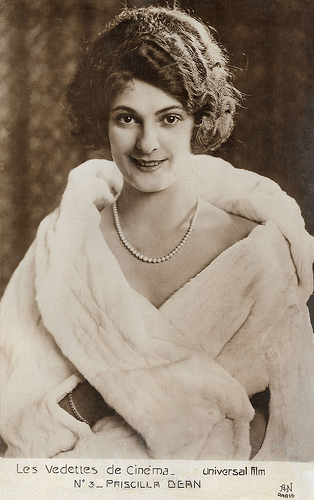
French postcard by A.N., Paris, in the Les Vedettes de Cinéma series, no. 3. Photo: Universal Film.
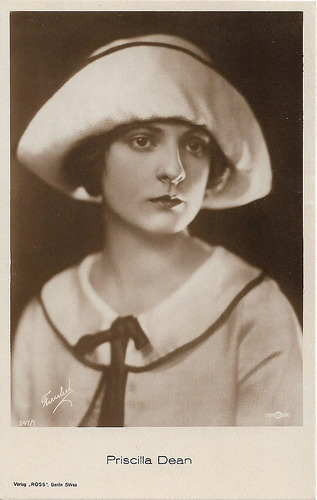
German postcard by Ross Verlag, no. 548/1, 1919-1924. Photo: Roman Freulich / Unfilman.
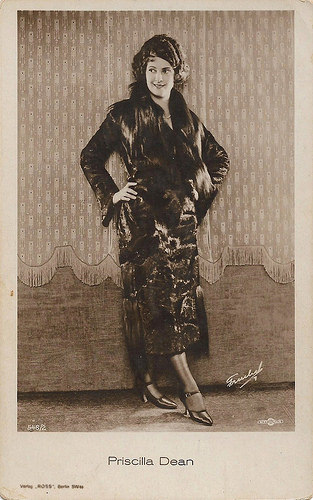
German postcard by Ross Verlag, no. 548/2, 1919-1924. Photo: Roman Freulich / Unfilman.
David Wark Griffith
Priscilla Dean was born in 1896 in New York City as the daughter of theatre actors. Her mother was popular stage actress May Preston Dean.
From when she was four, Priscilla played in her parents' productions. As a child, she pursued a stage career at the same time as being educated at a convent school until the age of fourteen. By age 10, she was a seasoned professional.
Dean made her film debut and appeared in two short films, released in 1912. One of them was directed by D. W. Griffith for the Biograph company, A Blot under 'Scutcheon (1912).
Until 1928, she contributed to 68 American silent films, including many short films directed by Jack Dillon made in the mid-1910s for the Vogue Company.
From 1916 onwards, she worked for IMP, which was later merged with other film companies into Universal. She played the female lead in the Eddie Lyons & Lee Moran comedies, directed by Louis Chaudet for Nestor, another company which was merged into Universal.
In 1917 she acted in films by Lois Weber such as Even As You and I (1917) and The Hand That Rocks the Cradle (1917).
Her appearance in the action serial The Gray Ghost (Stuart Paton, 1917) opposite Eddie Polo propelled her to stardom, and she began appearing in many of Universal's most prestigious productions.
Greta de Groat at Unsung Divas : "Priscilla Dean was a very unlikely diva. Her photos show a plain but cheerful looking woman, with rather heavy features, a crooked grin, and an unfashionably curvaceous figure. But on screen her intensity is unmatched. "
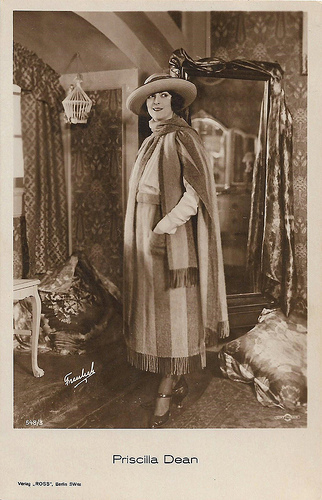
German postcard by Ross Verlag, no. 548/3, 1919-1924. Photo: Roman Freulich / Unfilman.
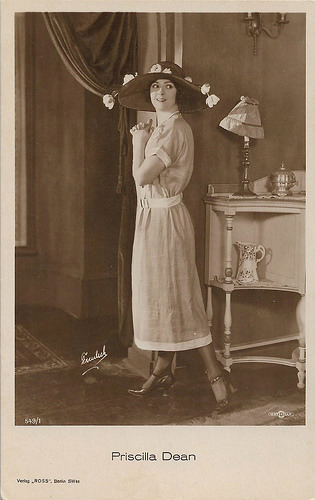
German postcard by Ross Verlag, no. 549/1, 1919-1924. Photo: Roman Freulich / Unfilman.
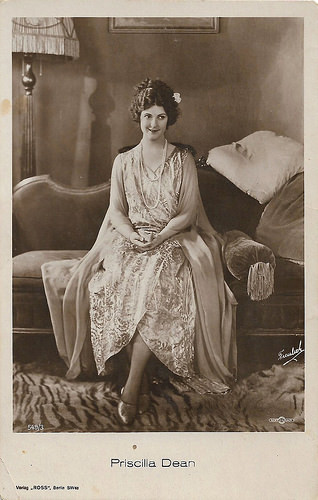
German postcard by Ross Verlag, no. 549/3, 1919-1924. Photo: Roman Freulich / Unfilman.
Tod Browning
Priscilla Dean is best known for her participation, between 1918 and 1923, in nine Universal films by Tod Browning. These films include The Wicked Darling (1919) in which she played a s pair of pickpockets with Lon Chaney , The Virgin of Stamboul (1920) with Wallace Beery, Outside the Law (1920), with Lon Chaney , Under Two Flags (1922), and White Tiger (1923), with Raymond Griffith.
Browning unleashed her talent. Her performance in Outside the Law (1920) is "startlingly fierce", according to Greta de Groat. In the French Foreign Legion melodrama Under two Flags (1922) she played Cigarette, a role re-created in a sound version by Claudette Colbert.
In The Virgin of Stamboul and Outside the Law, Dean played together with Wheeler Oakman, who was also under contract at Universal an was for a time her husband.
After 1923, Dean worked for several companies: she did quite a few films at Metropolitan, a few shorts at Hal Roach such as Slipping Wives (Fred Guiol, 1927), with Laurel & Hardy , and one or two productions at Hunt Stromberg and Columbia.
The coming of sound damaged her career. By the early 1930s she was appearing in low-budget films for small independent studios. Dean retired permanently from the screen after five talking pictures (three shorts in 1931 and two feature films in 1932).
Her last film was Klondike (Phil Rosen, 1932) with Thelma Todd and Lyle Talbot. Great de Groat: "Her starring career was brief, but there was nobody else quite like her."
Priscilla Dean was first married to Wheeler Oakman but they divorced in the mid-1920s. In 1928, she married Leslie Arnold in Mexico. Arnold was divorced, but one court called this invalid, making him a bigamist, but in the end that verdict was overruled.
Lt. Leslie Arnold had made history by flying around the world in 1924. Dean and Arnold remained married until his death in the 1960s. They had no children.
In 1987, Priscilla Dean died at her home in Leonia, New Jersey, after the complications of a fall one year earlier. She was 91.
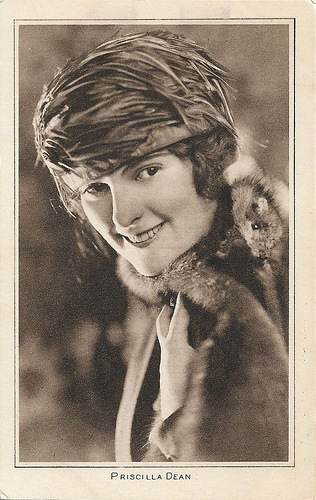
British postcard.
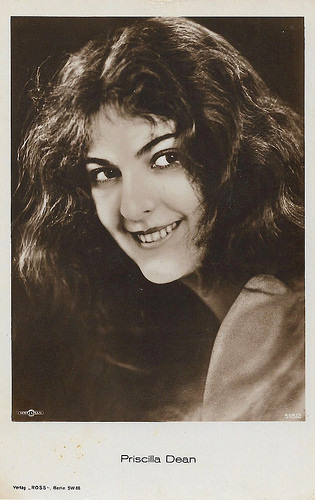
German postcard by Ross Verlag, no. 518/2, 1919-1924. Photo: Unfilman.
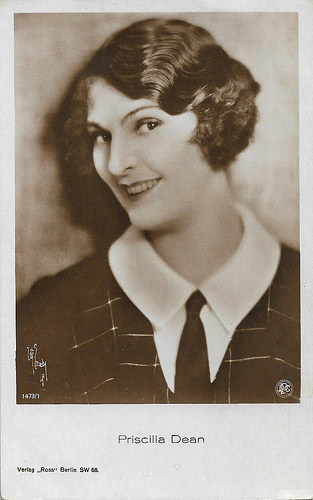
German postcard by Ross Verlag, no. 1473/1, 1927-1928. Photo: Walter F. Seely, Los Angeles / P.D.C.
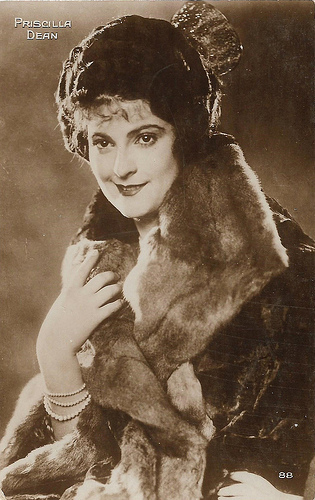
French postcard by Editions Cinémagazine, no. 88.
Sources: Greta de Groat (Unsung Divas), Michael Barson (Encyclopaedia Britannica), Silent Hollywood, Los Angeles Times, Wikipedia (Italian and English) and .

French postcard by A.N., Paris, in the Les Vedettes de Cinéma series, no. 3. Photo: Universal Film.

German postcard by Ross Verlag, no. 548/1, 1919-1924. Photo: Roman Freulich / Unfilman.

German postcard by Ross Verlag, no. 548/2, 1919-1924. Photo: Roman Freulich / Unfilman.
David Wark Griffith
Priscilla Dean was born in 1896 in New York City as the daughter of theatre actors. Her mother was popular stage actress May Preston Dean.
From when she was four, Priscilla played in her parents' productions. As a child, she pursued a stage career at the same time as being educated at a convent school until the age of fourteen. By age 10, she was a seasoned professional.
Dean made her film debut and appeared in two short films, released in 1912. One of them was directed by D. W. Griffith for the Biograph company, A Blot under 'Scutcheon (1912).
Until 1928, she contributed to 68 American silent films, including many short films directed by Jack Dillon made in the mid-1910s for the Vogue Company.
From 1916 onwards, she worked for IMP, which was later merged with other film companies into Universal. She played the female lead in the Eddie Lyons & Lee Moran comedies, directed by Louis Chaudet for Nestor, another company which was merged into Universal.
In 1917 she acted in films by Lois Weber such as Even As You and I (1917) and The Hand That Rocks the Cradle (1917).
Her appearance in the action serial The Gray Ghost (Stuart Paton, 1917) opposite Eddie Polo propelled her to stardom, and she began appearing in many of Universal's most prestigious productions.
Greta de Groat at Unsung Divas : "Priscilla Dean was a very unlikely diva. Her photos show a plain but cheerful looking woman, with rather heavy features, a crooked grin, and an unfashionably curvaceous figure. But on screen her intensity is unmatched. "

German postcard by Ross Verlag, no. 548/3, 1919-1924. Photo: Roman Freulich / Unfilman.

German postcard by Ross Verlag, no. 549/1, 1919-1924. Photo: Roman Freulich / Unfilman.

German postcard by Ross Verlag, no. 549/3, 1919-1924. Photo: Roman Freulich / Unfilman.
Tod Browning
Priscilla Dean is best known for her participation, between 1918 and 1923, in nine Universal films by Tod Browning. These films include The Wicked Darling (1919) in which she played a s pair of pickpockets with Lon Chaney , The Virgin of Stamboul (1920) with Wallace Beery, Outside the Law (1920), with Lon Chaney , Under Two Flags (1922), and White Tiger (1923), with Raymond Griffith.
Browning unleashed her talent. Her performance in Outside the Law (1920) is "startlingly fierce", according to Greta de Groat. In the French Foreign Legion melodrama Under two Flags (1922) she played Cigarette, a role re-created in a sound version by Claudette Colbert.
In The Virgin of Stamboul and Outside the Law, Dean played together with Wheeler Oakman, who was also under contract at Universal an was for a time her husband.
After 1923, Dean worked for several companies: she did quite a few films at Metropolitan, a few shorts at Hal Roach such as Slipping Wives (Fred Guiol, 1927), with Laurel & Hardy , and one or two productions at Hunt Stromberg and Columbia.
The coming of sound damaged her career. By the early 1930s she was appearing in low-budget films for small independent studios. Dean retired permanently from the screen after five talking pictures (three shorts in 1931 and two feature films in 1932).
Her last film was Klondike (Phil Rosen, 1932) with Thelma Todd and Lyle Talbot. Great de Groat: "Her starring career was brief, but there was nobody else quite like her."
Priscilla Dean was first married to Wheeler Oakman but they divorced in the mid-1920s. In 1928, she married Leslie Arnold in Mexico. Arnold was divorced, but one court called this invalid, making him a bigamist, but in the end that verdict was overruled.
Lt. Leslie Arnold had made history by flying around the world in 1924. Dean and Arnold remained married until his death in the 1960s. They had no children.
In 1987, Priscilla Dean died at her home in Leonia, New Jersey, after the complications of a fall one year earlier. She was 91.

British postcard.

German postcard by Ross Verlag, no. 518/2, 1919-1924. Photo: Unfilman.

German postcard by Ross Verlag, no. 1473/1, 1927-1928. Photo: Walter F. Seely, Los Angeles / P.D.C.

French postcard by Editions Cinémagazine, no. 88.
Sources: Greta de Groat (Unsung Divas), Michael Barson (Encyclopaedia Britannica), Silent Hollywood, Los Angeles Times, Wikipedia (Italian and English) and .
Published on November 06, 2018 22:00
November 5, 2018
American Vedettes, Part 2
On 28 October 2017, EFSP published our first selection from the French series Les Vedettes de Cinéma. The series was published in the 1920s by A.N. (Armand Noyer), located at Boulevard de Strasbourg in Paris. Then we focused on European stars, now on Hollywood stars. Yesterday we did a post on the male American stars, today we present 15 female stars of silent Hollywood.
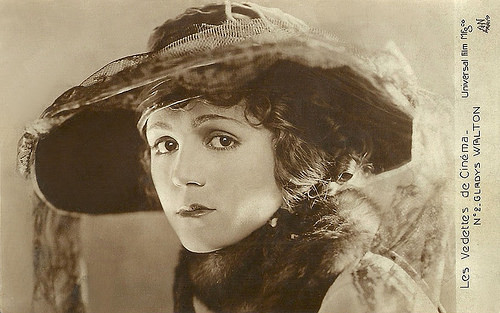
Gladys Walton. French postcard by A.N., Paris in the Les Vedettes de Cinéma series, no. 2. Photo: Universal.
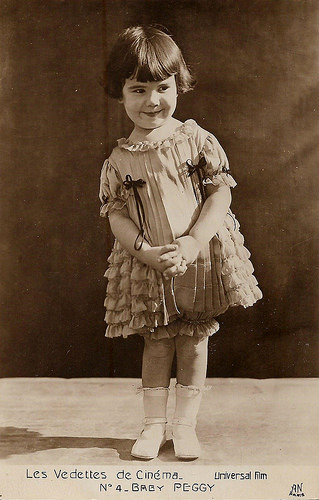
Baby Peggy . French postcard by A.N., Paris, in the Les Vedettes de Cinéma series, no. 4. Photo: Universal.
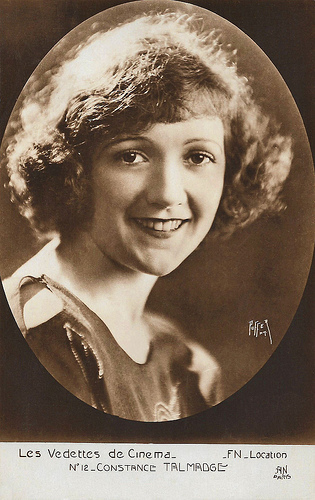
Constance Talmadge. French postcard by A.N., Paris, in the Les Vedettes de Cinéma series, no. 12. Photo: B. Frank Puffer / First National Location.
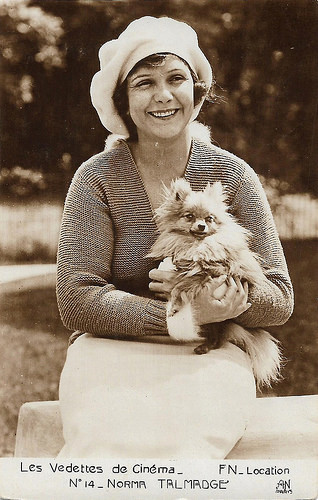
Norma Talmadge. French postcard by A.N., Paris, in the Les Vedettes de Cinéma series, no. 14. Photo: F.N. - Location (First National).
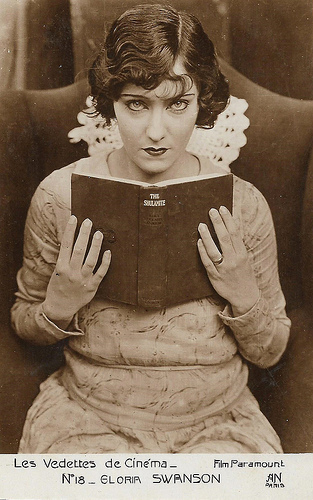
Gloria Swanson . French postcard by A.N., Paris, in the Les Vedettes de Cinéma series, no. 18. Photo: Paramount.
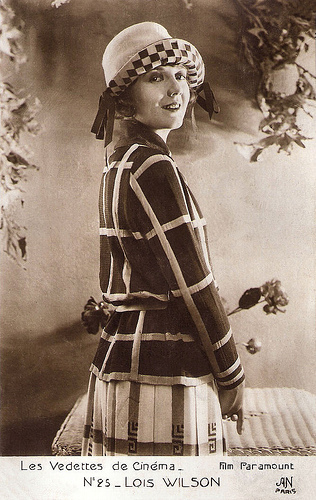
Lois Wilson. French postcard by A.N., Paris, in the Les Vedettes de Cinéma series, no. 25. Photo: Paramount.
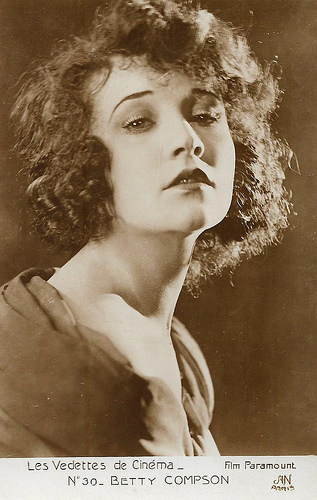
Betty Compson. French postcard by A.N., Paris, in the Les Vedettes de Cinéma series, no. 30. Photo: Paramount.
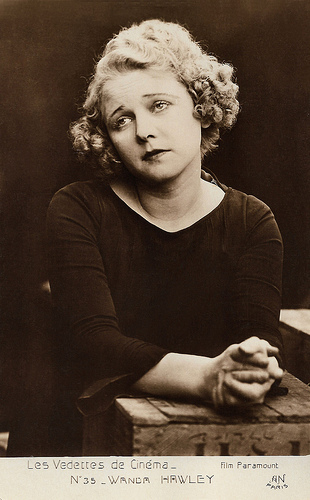
Wanda Hawley. French postcard by A.N., Paris, in the Les Vedettes de Cinéma series, no. 35. Photo: Paramount.
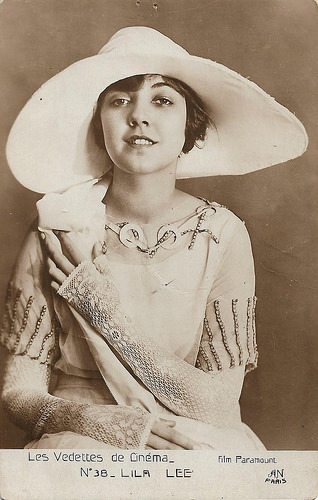
Lila Lee. French postcard by A.N., Paris, in the Les Vedettes de Cinéma series, no. 38. Photo: Paramount.
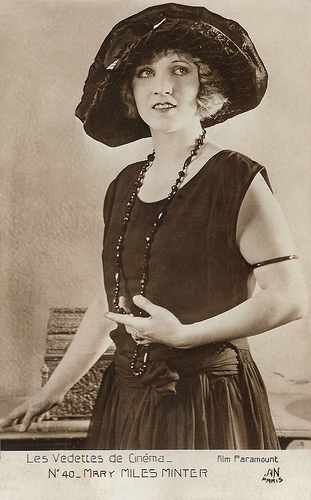
Mary Miles Minter. French postcard by A.N., Paris, in the Les Vedettes de Cinéma series, no. 40. Photo: Paramount.
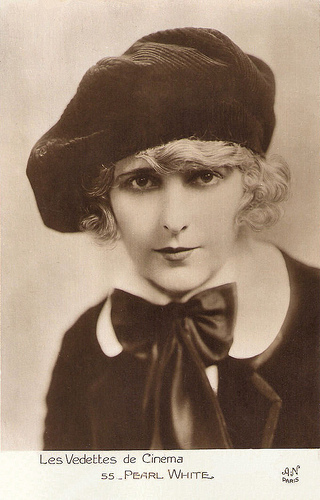
Pearl White. French postcard by A.N., Paris, in the Les Vedettes de Cinéma series, no. 55.
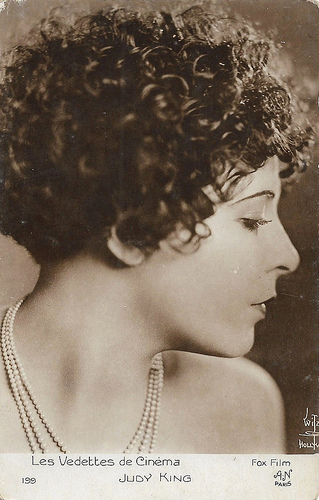
Judy King. French postcard by A.N., Paris, in the Les Vedettes de Cinéma series, no. 199. Photo: Albert Witzel / Fox.
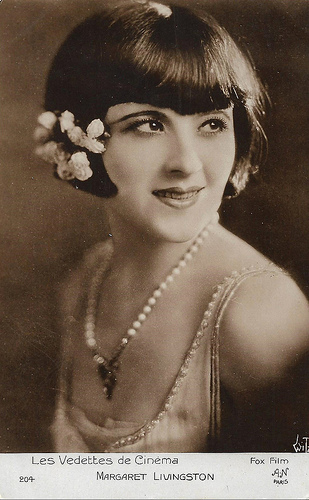
Margaret Livingston. French postcard by A.N., Paris, in the Les Vedettes de Cinéma series, no. 204. Photo: Albert Witzel / Fox.
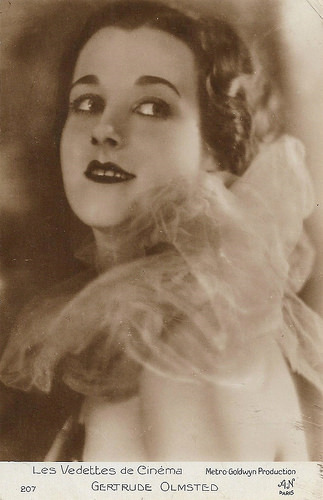
Gertrud Olmstead. French postcard by A.N., Paris, in the Les Vedettes de Cinéma series, no. 207. Photo: Metro-Goldwyn Production.
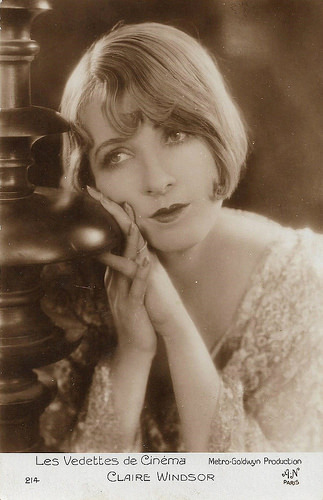
Claire Windsor. French postcard by A.N., Paris, in the Les Vedettes de Cinéma series, no. 214. Photo: Metro-Goldwyn Production.
November and December will be EFSP's Hollywood months with European postcards of American film stars and films. From the 1920s, the Hollywood studios had their own photo departments, so we will stop with our series on photographers and start a new series on the Hollywood studios. It starts next Saturday, 10 November, with Warner Bros.

Gladys Walton. French postcard by A.N., Paris in the Les Vedettes de Cinéma series, no. 2. Photo: Universal.

Baby Peggy . French postcard by A.N., Paris, in the Les Vedettes de Cinéma series, no. 4. Photo: Universal.

Constance Talmadge. French postcard by A.N., Paris, in the Les Vedettes de Cinéma series, no. 12. Photo: B. Frank Puffer / First National Location.

Norma Talmadge. French postcard by A.N., Paris, in the Les Vedettes de Cinéma series, no. 14. Photo: F.N. - Location (First National).

Gloria Swanson . French postcard by A.N., Paris, in the Les Vedettes de Cinéma series, no. 18. Photo: Paramount.

Lois Wilson. French postcard by A.N., Paris, in the Les Vedettes de Cinéma series, no. 25. Photo: Paramount.

Betty Compson. French postcard by A.N., Paris, in the Les Vedettes de Cinéma series, no. 30. Photo: Paramount.

Wanda Hawley. French postcard by A.N., Paris, in the Les Vedettes de Cinéma series, no. 35. Photo: Paramount.

Lila Lee. French postcard by A.N., Paris, in the Les Vedettes de Cinéma series, no. 38. Photo: Paramount.

Mary Miles Minter. French postcard by A.N., Paris, in the Les Vedettes de Cinéma series, no. 40. Photo: Paramount.

Pearl White. French postcard by A.N., Paris, in the Les Vedettes de Cinéma series, no. 55.

Judy King. French postcard by A.N., Paris, in the Les Vedettes de Cinéma series, no. 199. Photo: Albert Witzel / Fox.

Margaret Livingston. French postcard by A.N., Paris, in the Les Vedettes de Cinéma series, no. 204. Photo: Albert Witzel / Fox.

Gertrud Olmstead. French postcard by A.N., Paris, in the Les Vedettes de Cinéma series, no. 207. Photo: Metro-Goldwyn Production.

Claire Windsor. French postcard by A.N., Paris, in the Les Vedettes de Cinéma series, no. 214. Photo: Metro-Goldwyn Production.
November and December will be EFSP's Hollywood months with European postcards of American film stars and films. From the 1920s, the Hollywood studios had their own photo departments, so we will stop with our series on photographers and start a new series on the Hollywood studios. It starts next Saturday, 10 November, with Warner Bros.
Published on November 05, 2018 22:00
November 4, 2018
American Vedettes, Part 1
Before World War I, the European film industry ruled the world. The war destroyed the French studios and Hollywood started its victory in the international cinemas. And audiences all over the world simply loved the American movies, even in France. They adored the new American 'vedettes', as a popular series of film star postcards by Paris publisher A.N. (A. Noyer) shows: Les Vedettes de Cinéma. The postcards were published in the 1920s and today EFSP presents 14 postcards of the series with Hollywood men. The ladies will follow tomorrow.
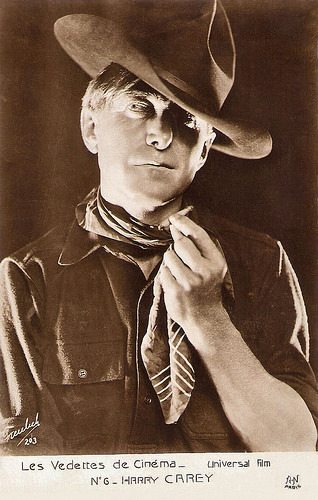
Harry Carey. French postcard by A.N. in the Les Vedettes de Cinéma series, Paris, no. 6. Photo: Roman Freulich / Universal.
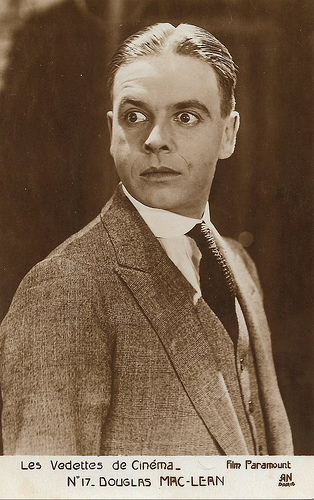
Douglas MacLean. French postcard by A.N. in the Les Vedettes de Cinéma series, Paris, no. 17. Photo: Paramount.
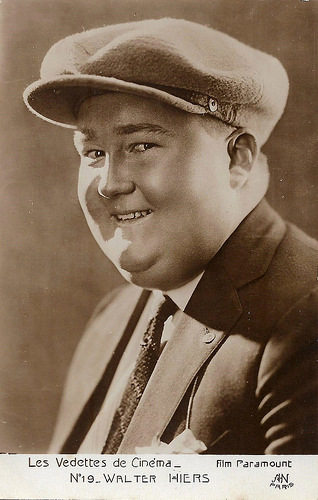
Walter Hiers. French postcard by A.N. in the Les Vedettes de Cinéma series, Paris, no. 19. Photo: Paramount.
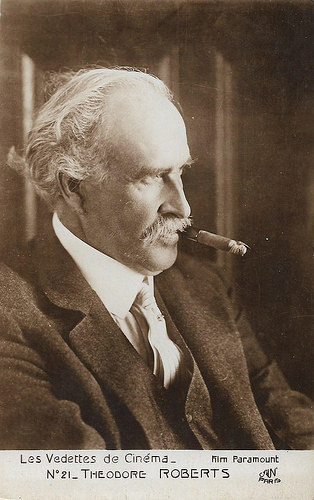
Theodore Roberts. French postcard by A.N. in the Les Vedettes de Cinéma series, Paris, no. 21. Photo: Paramount.
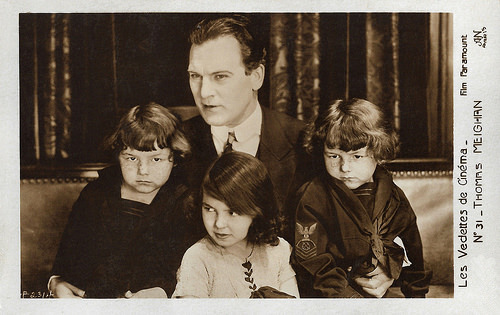
Thomas Meighan and his children. French postcard by A.N. Paris, in the Les Vedettes de Cinéma series, no. 21. Photo: Paramount.
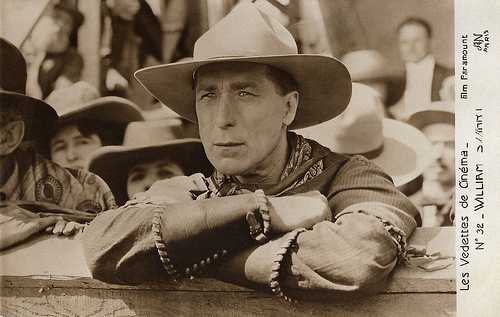
William Hart. French postcard by A.N. in the Les Vedettes de Cinéma series, Paris, no. 32. Photo: Film Paramount.
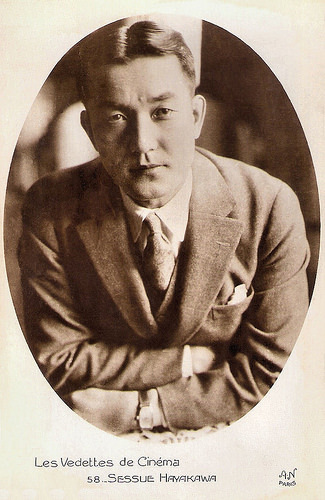
Sessue Hayakawa . French postcard by A.N. in the Les Vedettes de Cinéma series, Paris, no. 58.
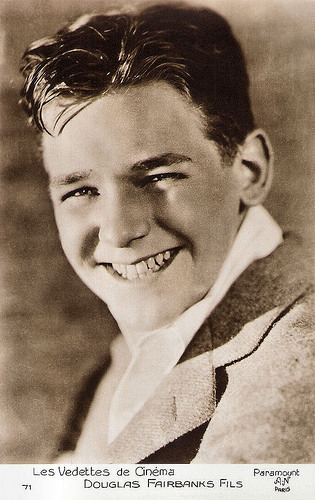
Douglas Fairbanks junior . French postcard by A.N. in the Les Vedettes de Cinéma series, Paris, no. 71. Photo: Paramount.
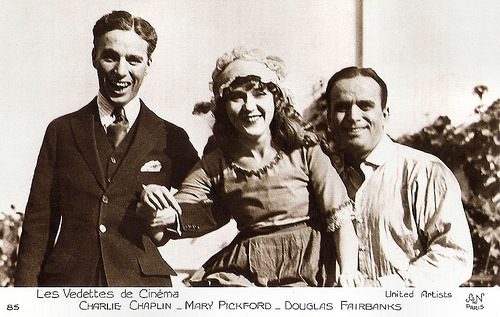
Charlie Chaplin , Mary Pickford and Douglas Fairbanks . French postcard by A.N. in the Les Vedettes de Cinéma series, Paris, no. 85. Photo: United Artists.
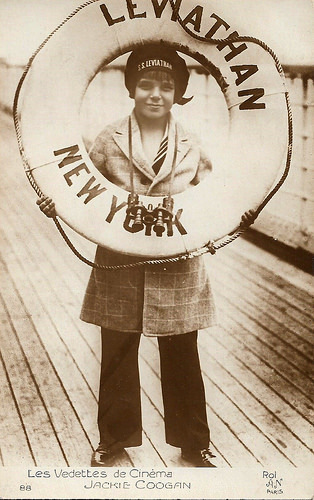
Jackie Coogan on board of SS Leviathan in 1924. French postcard by A.N. in the Les Vedettes de Cinéma series, Paris, no. 88. Photo: Rol.
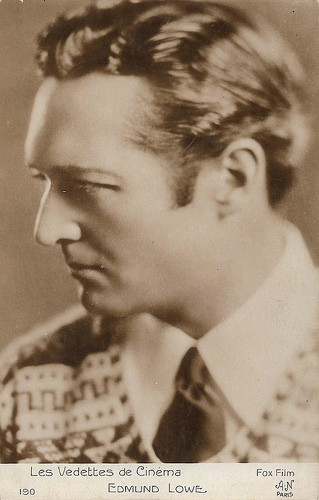
Edmund Lowe. French postcard by A.N. in the Les Vedettes de Cinéma series, Paris, no. 190. Photo: Fox.
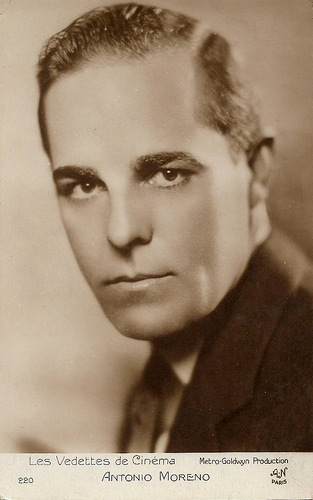
Antonio Moreno. French postcard by A.N. in the Les Vedettes de Cinéma series, Paris, no. 220. Photo: Metro-Goldwyn Production.
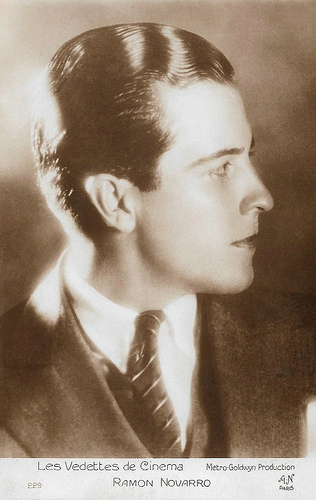
Ramon Novarro . French postcard by A.N. in the Les Vedettes de Cinéma series, Paris, no. 229. Photo: Metro-Goldwyn Production.
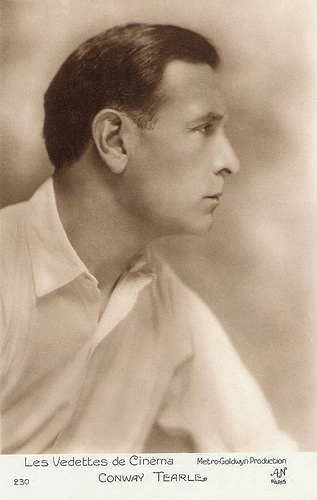
Conway Tearle. French postcard by A.N. in the Les Vedettes de Cinéma series, Paris, no. 230. Photo: Metro-Goldwyn Production.
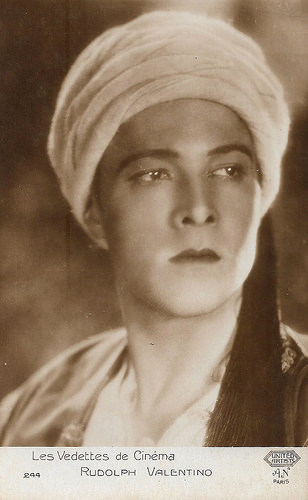
Rudolph Valentino . French postcard by A.N. in the Les Vedettes de Cinéma series, Paris, no. 244. Photo: United Artists. Publicity still for The Son of the Sheik (George Fitzmaurice, 1926).
To be continued.
See here our earlier post on A.N., Paris .

Harry Carey. French postcard by A.N. in the Les Vedettes de Cinéma series, Paris, no. 6. Photo: Roman Freulich / Universal.

Douglas MacLean. French postcard by A.N. in the Les Vedettes de Cinéma series, Paris, no. 17. Photo: Paramount.

Walter Hiers. French postcard by A.N. in the Les Vedettes de Cinéma series, Paris, no. 19. Photo: Paramount.

Theodore Roberts. French postcard by A.N. in the Les Vedettes de Cinéma series, Paris, no. 21. Photo: Paramount.

Thomas Meighan and his children. French postcard by A.N. Paris, in the Les Vedettes de Cinéma series, no. 21. Photo: Paramount.

William Hart. French postcard by A.N. in the Les Vedettes de Cinéma series, Paris, no. 32. Photo: Film Paramount.

Sessue Hayakawa . French postcard by A.N. in the Les Vedettes de Cinéma series, Paris, no. 58.

Douglas Fairbanks junior . French postcard by A.N. in the Les Vedettes de Cinéma series, Paris, no. 71. Photo: Paramount.

Charlie Chaplin , Mary Pickford and Douglas Fairbanks . French postcard by A.N. in the Les Vedettes de Cinéma series, Paris, no. 85. Photo: United Artists.

Jackie Coogan on board of SS Leviathan in 1924. French postcard by A.N. in the Les Vedettes de Cinéma series, Paris, no. 88. Photo: Rol.

Edmund Lowe. French postcard by A.N. in the Les Vedettes de Cinéma series, Paris, no. 190. Photo: Fox.

Antonio Moreno. French postcard by A.N. in the Les Vedettes de Cinéma series, Paris, no. 220. Photo: Metro-Goldwyn Production.

Ramon Novarro . French postcard by A.N. in the Les Vedettes de Cinéma series, Paris, no. 229. Photo: Metro-Goldwyn Production.

Conway Tearle. French postcard by A.N. in the Les Vedettes de Cinéma series, Paris, no. 230. Photo: Metro-Goldwyn Production.

Rudolph Valentino . French postcard by A.N. in the Les Vedettes de Cinéma series, Paris, no. 244. Photo: United Artists. Publicity still for The Son of the Sheik (George Fitzmaurice, 1926).
To be continued.
See here our earlier post on A.N., Paris .
Published on November 04, 2018 22:00
November 3, 2018
Gloria Grahame
American stage, film, television actress and singer Gloria Grahame (1923-1981) was often cast in Film Noirs as a tarnished beauty with an irresistible sexual allure. She received an Oscar for Best Supporting Actress nomination for Crossfire (1947), and would later win the award for The Bad and the Beautiful (1952). Her best known films are Sudden Fear (1952), Human Desire (1953), The Big Heat (1953), and Oklahoma! (1955), but her film career began to wane soon afterwards.
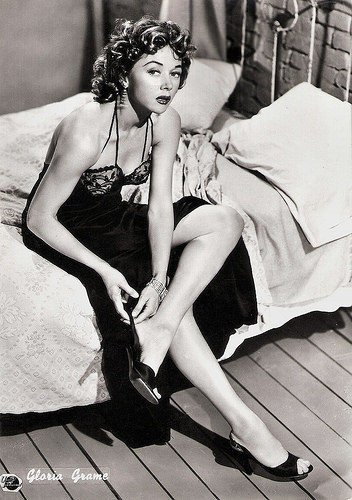
Italian postcard by Bromofoto, Milano, no. 1190. Photo: Universal International. Publicity still for Naked Alibi (Jerry Hopper, 1954).
A Tart with a Heart
Gloria Grahame Hallward was born in in Los Angeles, California in 1921. Her father, Reginald Michael Bloxam Hallward, was an architect and author; her mother, Jeanne McDougall, who used the stage name Jean Grahame, was a British stage actress and acting teacher. Her older sister, Joy Hallward became an actress who married John Mitchum, the younger brother of Robert Mitchum .
During Gloria's childhood and adolescence, her mother taught her acting. Grahame attended Hollywood High School before dropping out to pursue acting. She was signed to a contract with MGM Studios under her professional name after Louis B. Mayer saw her performing on Broadway.
Grahame made her film debut as a tart-with-a-heart in the sex comedy Blonde Fever (Richard Whorf, 1944) with Philip Dorn , and then scored one of her most widely praised roles as the flirtatious Violet Bick, saved from disgrace by James Stewart in It's a Wonderful Life (Frank Capra, 1946). MGM was not able to develop her potential as a star and her contract was sold to RKO Studios in 1947.
She was nominated for the Academy Award for Best Supporting Actress in Crossfire (Edward Dmytryk, 1947), a Film Noir which deals with the theme of anti-Semitism. During this time, she made films for several Hollywood studios. For Columbia Pictures, Grahame starred with Humphrey Bogart in another Film Noir, In a Lonely Place (Nicholas Ray, 1950), a performance for which she again gained praise.
In 1952, Grahame starred in four major Hollywood-productions, including a part in the Film Noir Sudden Fear (David Miller, 1952), starring Joan Crawford, and a reunion with James Stewart in Cecil B. DeMille’s The Greatest Show on Earth, which won the Best Picture Oscar in 1953.
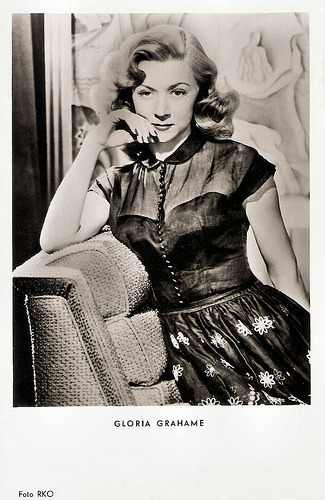
German postcard by Kunst und Bild, Berlin, no. A 791. Photo: RKO. Publicity still for Sudden Fear (David Miller, 1952).
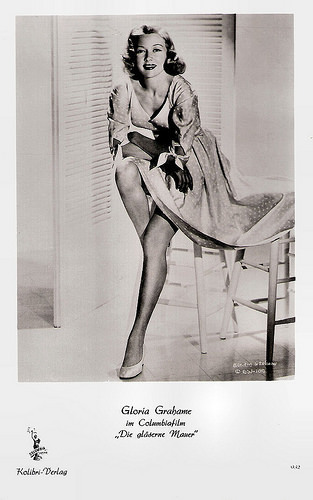
German postcard by Kolibri-Verlag, no. 032. Photo: Columbia. Publicity still for The Glass Wall (Maxwell Shane, 1953).
The Mysterious Bad Girl of Film Noir
29-year-old Gloria Grahame was on the verge of superstardom, when she herself won the Supporting Actress Oscar for her performance in The Bad and the Beautiful (Vincente Minnelli, 1952), starring Lana Turner and Kirk Douglas .
Sadly, following her Oscar victory, the beauty Grahame embodied so artfully on screen never reflected the personal turmoil festering under the surface. Her two marriages had ended in a divorce: one from allegedly abusive actor Stanley Clements (1945-1948), the other from Rebel Without a Cause director Nicholas Ray (1948-1952), with whom she had a son, Timothy.
In the following years, her image hardened as the mysterious bad girl of Film Noir in The Big Heat (Fritz Lang, 1953) and Human Desire (Fritz Lang, 1954). In a classic, horrifying off-screen scene in The Big Heat, her character, mob moll Debby Marsh is scarred by hot coffee thrown in her face by Lee Marvin's character.
In 1954, she acted and sang in the adaptation of Richard Rodgers and Oscar Hammerstein’s musical Oklahoma! (Fred Zinnemann, 1955) as the 'girl who can’t say no,' Ado Annie. That same year she married writer-producer Cy Howard. After Oklahoma!, Grahame scaled back her work. There were rumours that she had been difficult to work with on the set of Oklahoma!.
Two years later, she divorced Howard. In 1960, she married former stepson Tony Ray, son of Nicholas Ray. This led Nicholas Ray and Cy Howard to each sue for custody of each's child by Grahame, putting gossip columnists and scandal sheets into overdrive. Rumours circulated that Grahame had initially seduced Tony when he was just 13. Along with her tarnished professional reputation, this gossip made her a Hollywood outcast.
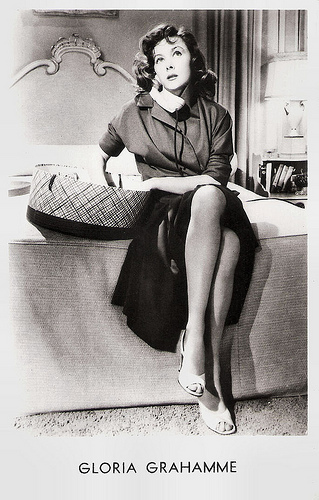
Dutch postcard.
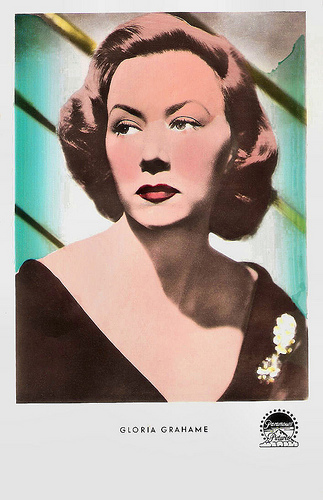
German postcard by Kunst und Bild, Berlin, no. D 7. Photo: Paramount.
A nervous breakdown and electroshock therapy
In the 1960s, Gloria Grahame dedicated herself to raising her growing family after having two sons with Tony. The stress of the scandal, her waning career and her custody battle with Howard took its toll on Grahame and she had a nervous breakdown. She later underwent electroshock therapy in 1964.
After that, she began a slow return to the theatre. She popped up as an occasional guest on TV series, and when she found her way back to the big screen, it was in exploitation films like Blood and Lace (Philip S. Gilbert, 1971) and Mama’s Dirty Girls (John Hayes, 1974).
In March, 1974, Grahame was diagnosed with breast cancer. She underwent radiation treatment, changed her diet, stopped smoking and drinking alcohol, and also sought homoeopathic remedies. In less than a year the cancer went into remission. Grahame never reclaimed her former glory, but the Oscar itself stood proudly on her mantel, an enduring reminder of her accomplishments.
In 1978, she met aspiring actor Peter Turner, while she was in Britain working on a stage production of W. Somerset Maugham’s Rain. Although Turner was nearly three decades her junior, they had a whirlwind romance. She co-starred in the British heist film A Nightingale Sang in Berkeley Square (Ralph Thomas, 1979) starring Richard Jordan, Oliver Tobias , and David Niven .
In 1980 followed her last major film, Melvin and Howard, (Jonathan Demme, 1980), in which she played Mary Steenburgen’s mother. The cancer returned in 1980 but Grahame refused to acknowledge her diagnosis or seek radiation treatment. Despite her failing health, Grahame continued working in stage productions in the United States and the United Kingdom.
At age 57, Gloria Grahame died in 1981 in a New York hospital from cancer-related complications. Peter Turner wrote about their love story in his memoir, Film Stars Don’t Die in Liverpool, which director Paul McGuigan adapted in 2017 into an excellent film starring Annette Bening and Jamie Bell.
Trailer The Big Heat (1953). Source: Chloroform and Silver Nitrate (YouTube).
Trailer Film Stars Don't Die in Liverpool (2017). Source: El Proyector MX (YouTube).
Sources: Joey Nolfi (Entertainment Weekly), Wikipedia and .

Italian postcard by Bromofoto, Milano, no. 1190. Photo: Universal International. Publicity still for Naked Alibi (Jerry Hopper, 1954).
A Tart with a Heart
Gloria Grahame Hallward was born in in Los Angeles, California in 1921. Her father, Reginald Michael Bloxam Hallward, was an architect and author; her mother, Jeanne McDougall, who used the stage name Jean Grahame, was a British stage actress and acting teacher. Her older sister, Joy Hallward became an actress who married John Mitchum, the younger brother of Robert Mitchum .
During Gloria's childhood and adolescence, her mother taught her acting. Grahame attended Hollywood High School before dropping out to pursue acting. She was signed to a contract with MGM Studios under her professional name after Louis B. Mayer saw her performing on Broadway.
Grahame made her film debut as a tart-with-a-heart in the sex comedy Blonde Fever (Richard Whorf, 1944) with Philip Dorn , and then scored one of her most widely praised roles as the flirtatious Violet Bick, saved from disgrace by James Stewart in It's a Wonderful Life (Frank Capra, 1946). MGM was not able to develop her potential as a star and her contract was sold to RKO Studios in 1947.
She was nominated for the Academy Award for Best Supporting Actress in Crossfire (Edward Dmytryk, 1947), a Film Noir which deals with the theme of anti-Semitism. During this time, she made films for several Hollywood studios. For Columbia Pictures, Grahame starred with Humphrey Bogart in another Film Noir, In a Lonely Place (Nicholas Ray, 1950), a performance for which she again gained praise.
In 1952, Grahame starred in four major Hollywood-productions, including a part in the Film Noir Sudden Fear (David Miller, 1952), starring Joan Crawford, and a reunion with James Stewart in Cecil B. DeMille’s The Greatest Show on Earth, which won the Best Picture Oscar in 1953.

German postcard by Kunst und Bild, Berlin, no. A 791. Photo: RKO. Publicity still for Sudden Fear (David Miller, 1952).

German postcard by Kolibri-Verlag, no. 032. Photo: Columbia. Publicity still for The Glass Wall (Maxwell Shane, 1953).
The Mysterious Bad Girl of Film Noir
29-year-old Gloria Grahame was on the verge of superstardom, when she herself won the Supporting Actress Oscar for her performance in The Bad and the Beautiful (Vincente Minnelli, 1952), starring Lana Turner and Kirk Douglas .
Sadly, following her Oscar victory, the beauty Grahame embodied so artfully on screen never reflected the personal turmoil festering under the surface. Her two marriages had ended in a divorce: one from allegedly abusive actor Stanley Clements (1945-1948), the other from Rebel Without a Cause director Nicholas Ray (1948-1952), with whom she had a son, Timothy.
In the following years, her image hardened as the mysterious bad girl of Film Noir in The Big Heat (Fritz Lang, 1953) and Human Desire (Fritz Lang, 1954). In a classic, horrifying off-screen scene in The Big Heat, her character, mob moll Debby Marsh is scarred by hot coffee thrown in her face by Lee Marvin's character.
In 1954, she acted and sang in the adaptation of Richard Rodgers and Oscar Hammerstein’s musical Oklahoma! (Fred Zinnemann, 1955) as the 'girl who can’t say no,' Ado Annie. That same year she married writer-producer Cy Howard. After Oklahoma!, Grahame scaled back her work. There were rumours that she had been difficult to work with on the set of Oklahoma!.
Two years later, she divorced Howard. In 1960, she married former stepson Tony Ray, son of Nicholas Ray. This led Nicholas Ray and Cy Howard to each sue for custody of each's child by Grahame, putting gossip columnists and scandal sheets into overdrive. Rumours circulated that Grahame had initially seduced Tony when he was just 13. Along with her tarnished professional reputation, this gossip made her a Hollywood outcast.

Dutch postcard.

German postcard by Kunst und Bild, Berlin, no. D 7. Photo: Paramount.
A nervous breakdown and electroshock therapy
In the 1960s, Gloria Grahame dedicated herself to raising her growing family after having two sons with Tony. The stress of the scandal, her waning career and her custody battle with Howard took its toll on Grahame and she had a nervous breakdown. She later underwent electroshock therapy in 1964.
After that, she began a slow return to the theatre. She popped up as an occasional guest on TV series, and when she found her way back to the big screen, it was in exploitation films like Blood and Lace (Philip S. Gilbert, 1971) and Mama’s Dirty Girls (John Hayes, 1974).
In March, 1974, Grahame was diagnosed with breast cancer. She underwent radiation treatment, changed her diet, stopped smoking and drinking alcohol, and also sought homoeopathic remedies. In less than a year the cancer went into remission. Grahame never reclaimed her former glory, but the Oscar itself stood proudly on her mantel, an enduring reminder of her accomplishments.
In 1978, she met aspiring actor Peter Turner, while she was in Britain working on a stage production of W. Somerset Maugham’s Rain. Although Turner was nearly three decades her junior, they had a whirlwind romance. She co-starred in the British heist film A Nightingale Sang in Berkeley Square (Ralph Thomas, 1979) starring Richard Jordan, Oliver Tobias , and David Niven .
In 1980 followed her last major film, Melvin and Howard, (Jonathan Demme, 1980), in which she played Mary Steenburgen’s mother. The cancer returned in 1980 but Grahame refused to acknowledge her diagnosis or seek radiation treatment. Despite her failing health, Grahame continued working in stage productions in the United States and the United Kingdom.
At age 57, Gloria Grahame died in 1981 in a New York hospital from cancer-related complications. Peter Turner wrote about their love story in his memoir, Film Stars Don’t Die in Liverpool, which director Paul McGuigan adapted in 2017 into an excellent film starring Annette Bening and Jamie Bell.
Trailer The Big Heat (1953). Source: Chloroform and Silver Nitrate (YouTube).
Trailer Film Stars Don't Die in Liverpool (2017). Source: El Proyector MX (YouTube).
Sources: Joey Nolfi (Entertainment Weekly), Wikipedia and .
Published on November 03, 2018 23:00
November 2, 2018
Photo by Freulich
Polish-born photographer Roman Freulich (1898–1974) was a pioneer in the Hollywood film industry, who worked for Universal and later for Republic. He made countless popular glamour shots of the stars which were also used for many European film star postcards, but he also did still photography for several classic films and made some interesting independent films. His brother Jack and nephew Henry were also well known Hollywood photographers.
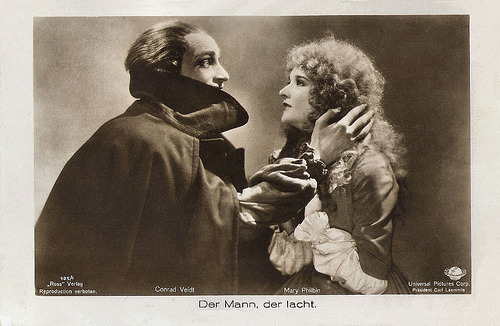
Conrad Veidt and Mary Philbin. German postcard by Ross Verlag, no. 105/1. Photo: Universal Pictures Corp. Publicity still for The Man Who Laughs (Paul Leni, 1928).

Harry Carey. French postcard by A.N., Paris, in the series Les Vedettes de Cinema, no. 6. Photo: Universal Film / Roman Freulich, no. 203.
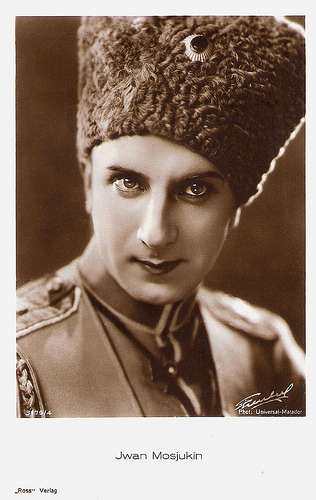
Ivan Mozzhukhin . German postcard by Ross Verlag, no. 3179/4, 1928-1929. Photo: Roman Freulich / Universal / Matador. Publicity still for Surrender (Edward Sloman, 1927).
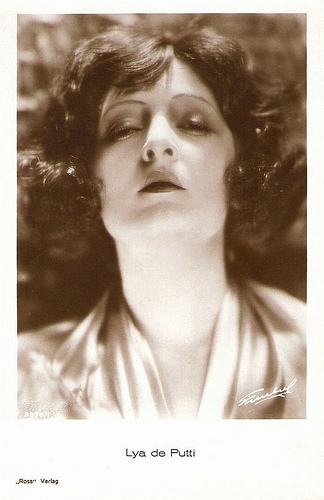
Lya de Putti . German postcard by Ross Verlag, no. 3370/1, 1928-1929. Photo: Roman Freulich.
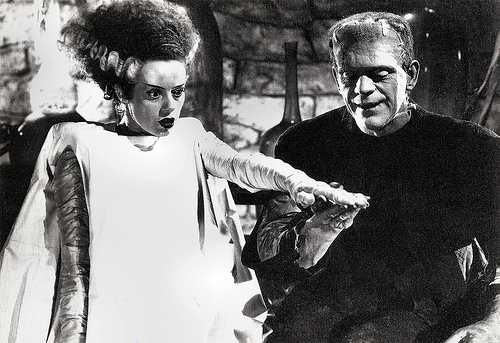
Boris Karloff and Elsa Lanchester. American postcard by Classico San Francisco, no. 233/007. Photo: Roman Freulich / Universal Pictures. Publicity still for The Bride of Frankenstein (James Whale, 1935).
Universal
Roman Freulich was born in 1898 in Czestochowa, Poland, Russian Empire (now Czestochowa, Slaskie, Poland). His parents were no longer young — Isaac Freulich was probably about 50 in 1898 and Nisla was 41. At Roman’s birth, his oldest sibling, his sister Sura Rifka was 20. His oldest brother Jacob, was 18.
He attended both grammar school and gymnasium — the equivalent of an American high school. He was quick to learn and did well in his studies — he became proficient in Russian, Polish, German and Yiddish — and acquired a taste for art, literature and classical music.
As a young teen he became active in the Jewish Socialist movement. Probably against the wishes of his mother and his father he began distributing literature for the movement in his after school time.
Late in 1912, Roman’s after school political activities became worrisome, and he immigrated with his father and a sister to the United States to join his eldest brother Jack (Jacob) in the Bronx. Freulich trained with New York photographer Samuel Lumiere.
In 1920, Freulich moved to Hollywood, where his brother Jack had become a portrait photographer at Universal Pictures. Jack's son, Henry Freulich, would also become a well known still photographer in Hollywood during the 1920s.
According to IMDb , Roman did the still photography for the silent film Outside the Law (Tod Browning, 1920), but it probably was his brother Jack while Roman was confined to a Sanatorium at the time.
In October 1920, Jack had checked Roman into the Barlow Tubercular Sanatorium in Chavez Ravine near downtown Los Angeles. Roman spent the next 15 months of his life there.
In 1922, Roman met his future wife, Katia Merkin. After his honeymoon, a job as a still photographer at Universal was waiting for Roman in California.
During his first 12 years at Universal, he worked closely with his brother and undoubtedly learned a great deal about production work, publicity shots and portraiture.
Among the films for which he did the still photography are The Phantom of the Opera (Rupert Julian, 1925) with Lon Chaney , The Man Who Laughs (Paul Leni, 1928) starring Conrad Veidt , All Quiet on the Western Front (Lewis Milestone, 1930), and Dracula (Tod Browning, 1931) featuring Bela Lugosi .
He also did the still photography for the horror films by James Whale, Frankenstein (James Whale, 1930) with Colin Clive and Boris Karloff , The Old Dark House (James Whale, 1932), The Invisible Man (James Whale, 1933) featuring Claude Rains, and The Bride of Frankenstein (James Whale, 1935) with Boris Karloff and Elsa Lanchester.
Another horror classic for which he did the still photography is The Black Cat (Edward G. Ulmer, 1934) starring both Boris Karloff and Bela Lugosi .
Later in the 1930s, he photographed for Universal such musicals as the Deanna Durbin vehicles One Hundred Men And A Girl (Henry Koster, 1937) and Mad About Music (Norman Taurog, 1938) and The Under-Pup (Richard Wallace, 1939) with Gloria Jean.
In 1941, 1942, 1944, and 1947 he won awards at the Hollywood Studio Still Photography Show, sponsored by the Academy of Motion Picture Arts and Sciences.
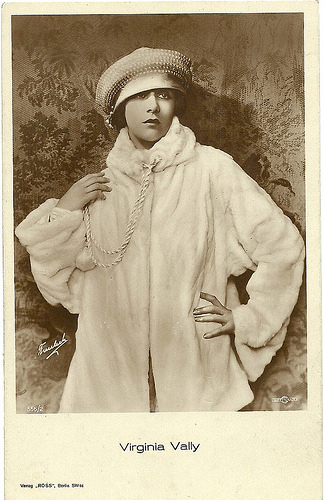
Virginia Vally. German postcard by Ross Verlag, Berlin, no. 556/2, 1919-1924. Photo: Roman Freulich. Collection: Didier Hanson.
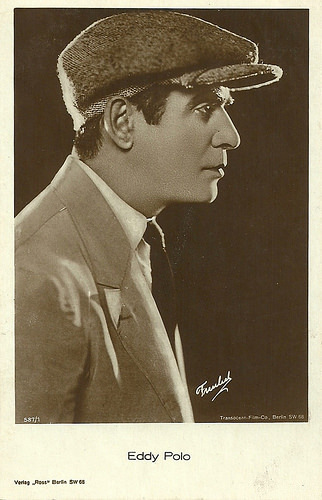
Eddie Polo . German postcard by Ross Verlag, no. 587/1. Photo: Roman Freulich / Transocean-Film Co., Berlin.
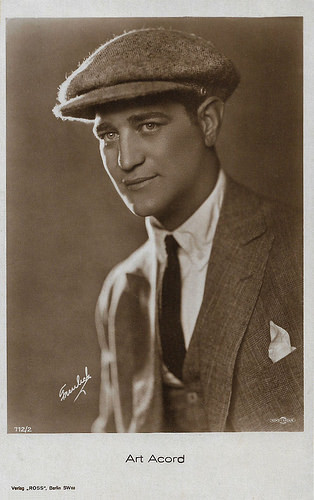
Art Acord. German postcard by Ross Verlag, no. 712/2, 1925-1926. Photo: Roman Freulich / Universal.
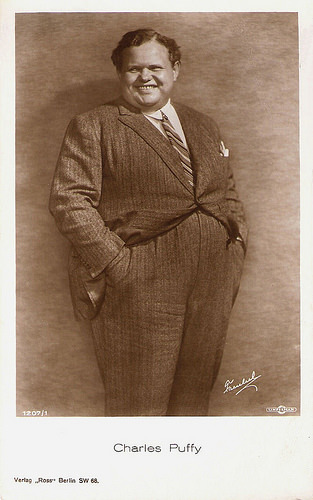
Charles Puffy . German postcard by Ross Verlag, no. 1207/1, 1927-1928. Photo: Roman Freulich / Unfilman (Universal).
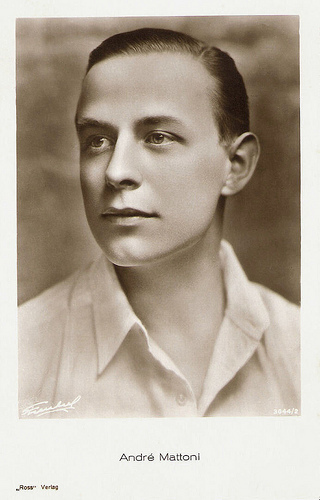
André Mattoni . German postcard by Ross Verlag, no. 3064/2, 1928-1929. Photo: Roman Freulich.
Republic
In 1944, Roman Freulich was offered a position at Republic Studios as head of its still department. During his 13 years at Republic the Western played the same role as the horror film had played at Universal — it was the company bread and butter.
Thus photographs of John Wayne, Roy Rogers, Dale Evans, 'Wild Bill' Elliot, Gabby Hayes, Gene Autrey and the Sons of the Pioneers began to take a prominent place in Roman’s portfolio.
He photographed Roy Rogers Westerns like Don't Fence Me In (John English, 1945) but also She Wore a Yellow Ribbon (John Ford, 1949), Sands of Iwo Jima (Allan Dwan, 1949) and John Ford’s The Quiet Man (1952), all starring John Wayne.
In the late 1950s, after Republic ceased production, Freulich freelanced, mostly for United Artists, until the mid-1960s. He worked on such B-films as the prostitution drama Vice Raid (Edward L. Cahn, 1959) with Mamie van Doren , and the Western Young Jesse James (William F. Claxton, 1960).
Freulich's immigration to America and the loss of his family members who had remained in Poland during the Holocaust are two legacies that distinguished Freulich from his fellow cameramen in Hollywood. In 1938. Freulich had made a trip to Poland in part to encourage family members to immigrate to the United States. He made photos of his family in Lodz and also made images of street scenes in Łódź, and two images taken in Warsaw.
The remarkable output of Freulich's independent work, consisting of film projects that ventured far beyond the relative professional shelter provided by his popular glamour shots. Freulich sought to give voice to the voiceless as evidenced in his self-produced short film Broken Earth (Roman Freulich, 1936) – the first film to feature a black actor (Clarence Muse) in a starring role – as well as his collaborations with the actor Paul Robeson.
Freulich authored Soldiers in Judea, Stories and Vignettes of the Jewish Legion (1964) and The Hill of Life (1968), a fictionalised biography of Joseph Trumpeldor.
Two years later, he worked for the last time as still photographer on a film, Tora, Tora, Tora (Richard Fleischer, Kinji Fukasaku, 1970).
Roman Freulich died in 1974 in West Los Angeles. He was 76.
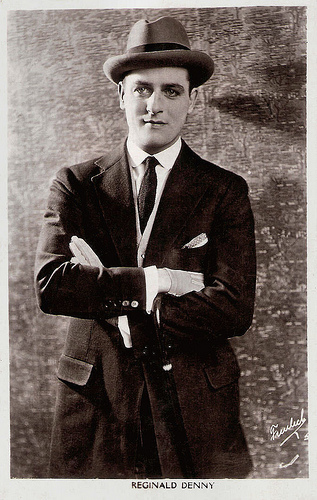
Reginald Denny . British postcard in the Picturegoer series, no. 74. Photo: Roman Freulich.
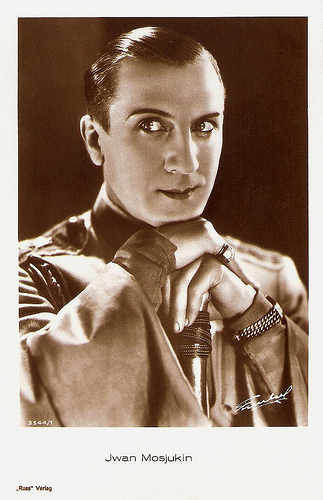
Ivan Mozzhukhin . German postcard by Ross-Verlag, no. 1265/1, 1927-1928. Photo: Roman Freulich. Publicity still for Surrender (Edward Sloman, 1927).
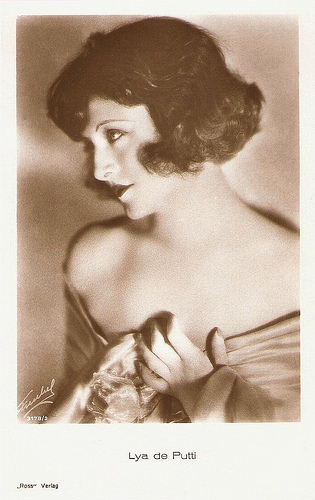
Lya de Putti . German postcard by Ross Verlag, no. 3178/2, 1928-1929. Photo: Roman Freulich.
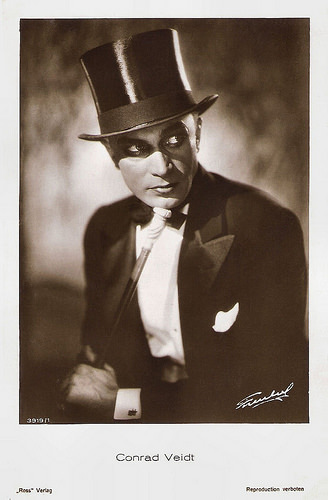
Conrad Veidt . German postcard by Ross Verlag, Berlin, no. 3919/1, 1928-1929. Photo: Roman Freulich.
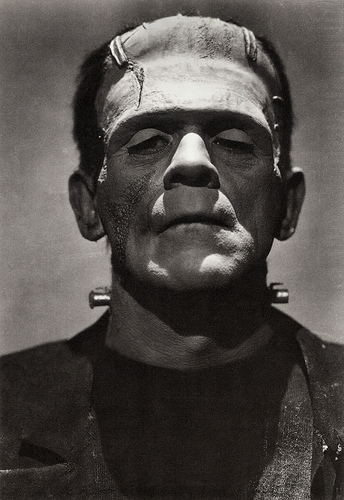
Boris Karloff . American postcard by Classico San Francisco, no. 233/06. Photo: Roman Freulich / Universal Pictures. Publicity still for Frankenstein (James Whale, 1931).
Sources: Joan Abramson (The Halborns), Sarah A. Buchanan (History of Photography), Mptv, Wikipedia and
November and December will be EFSP's Hollywood months with European postcards of American film stars and films. From the 1920s on, the Hollywood studios had their own photo departments, so we will stop with our series on photographers and start a new series on the Hollywood studios. It starts next Saturday, 10 November, with Warner Bros.

Conrad Veidt and Mary Philbin. German postcard by Ross Verlag, no. 105/1. Photo: Universal Pictures Corp. Publicity still for The Man Who Laughs (Paul Leni, 1928).

Harry Carey. French postcard by A.N., Paris, in the series Les Vedettes de Cinema, no. 6. Photo: Universal Film / Roman Freulich, no. 203.

Ivan Mozzhukhin . German postcard by Ross Verlag, no. 3179/4, 1928-1929. Photo: Roman Freulich / Universal / Matador. Publicity still for Surrender (Edward Sloman, 1927).

Lya de Putti . German postcard by Ross Verlag, no. 3370/1, 1928-1929. Photo: Roman Freulich.

Boris Karloff and Elsa Lanchester. American postcard by Classico San Francisco, no. 233/007. Photo: Roman Freulich / Universal Pictures. Publicity still for The Bride of Frankenstein (James Whale, 1935).
Universal
Roman Freulich was born in 1898 in Czestochowa, Poland, Russian Empire (now Czestochowa, Slaskie, Poland). His parents were no longer young — Isaac Freulich was probably about 50 in 1898 and Nisla was 41. At Roman’s birth, his oldest sibling, his sister Sura Rifka was 20. His oldest brother Jacob, was 18.
He attended both grammar school and gymnasium — the equivalent of an American high school. He was quick to learn and did well in his studies — he became proficient in Russian, Polish, German and Yiddish — and acquired a taste for art, literature and classical music.
As a young teen he became active in the Jewish Socialist movement. Probably against the wishes of his mother and his father he began distributing literature for the movement in his after school time.
Late in 1912, Roman’s after school political activities became worrisome, and he immigrated with his father and a sister to the United States to join his eldest brother Jack (Jacob) in the Bronx. Freulich trained with New York photographer Samuel Lumiere.
In 1920, Freulich moved to Hollywood, where his brother Jack had become a portrait photographer at Universal Pictures. Jack's son, Henry Freulich, would also become a well known still photographer in Hollywood during the 1920s.
According to IMDb , Roman did the still photography for the silent film Outside the Law (Tod Browning, 1920), but it probably was his brother Jack while Roman was confined to a Sanatorium at the time.
In October 1920, Jack had checked Roman into the Barlow Tubercular Sanatorium in Chavez Ravine near downtown Los Angeles. Roman spent the next 15 months of his life there.
In 1922, Roman met his future wife, Katia Merkin. After his honeymoon, a job as a still photographer at Universal was waiting for Roman in California.
During his first 12 years at Universal, he worked closely with his brother and undoubtedly learned a great deal about production work, publicity shots and portraiture.
Among the films for which he did the still photography are The Phantom of the Opera (Rupert Julian, 1925) with Lon Chaney , The Man Who Laughs (Paul Leni, 1928) starring Conrad Veidt , All Quiet on the Western Front (Lewis Milestone, 1930), and Dracula (Tod Browning, 1931) featuring Bela Lugosi .
He also did the still photography for the horror films by James Whale, Frankenstein (James Whale, 1930) with Colin Clive and Boris Karloff , The Old Dark House (James Whale, 1932), The Invisible Man (James Whale, 1933) featuring Claude Rains, and The Bride of Frankenstein (James Whale, 1935) with Boris Karloff and Elsa Lanchester.
Another horror classic for which he did the still photography is The Black Cat (Edward G. Ulmer, 1934) starring both Boris Karloff and Bela Lugosi .
Later in the 1930s, he photographed for Universal such musicals as the Deanna Durbin vehicles One Hundred Men And A Girl (Henry Koster, 1937) and Mad About Music (Norman Taurog, 1938) and The Under-Pup (Richard Wallace, 1939) with Gloria Jean.
In 1941, 1942, 1944, and 1947 he won awards at the Hollywood Studio Still Photography Show, sponsored by the Academy of Motion Picture Arts and Sciences.

Virginia Vally. German postcard by Ross Verlag, Berlin, no. 556/2, 1919-1924. Photo: Roman Freulich. Collection: Didier Hanson.

Eddie Polo . German postcard by Ross Verlag, no. 587/1. Photo: Roman Freulich / Transocean-Film Co., Berlin.

Art Acord. German postcard by Ross Verlag, no. 712/2, 1925-1926. Photo: Roman Freulich / Universal.

Charles Puffy . German postcard by Ross Verlag, no. 1207/1, 1927-1928. Photo: Roman Freulich / Unfilman (Universal).

André Mattoni . German postcard by Ross Verlag, no. 3064/2, 1928-1929. Photo: Roman Freulich.
Republic
In 1944, Roman Freulich was offered a position at Republic Studios as head of its still department. During his 13 years at Republic the Western played the same role as the horror film had played at Universal — it was the company bread and butter.
Thus photographs of John Wayne, Roy Rogers, Dale Evans, 'Wild Bill' Elliot, Gabby Hayes, Gene Autrey and the Sons of the Pioneers began to take a prominent place in Roman’s portfolio.
He photographed Roy Rogers Westerns like Don't Fence Me In (John English, 1945) but also She Wore a Yellow Ribbon (John Ford, 1949), Sands of Iwo Jima (Allan Dwan, 1949) and John Ford’s The Quiet Man (1952), all starring John Wayne.
In the late 1950s, after Republic ceased production, Freulich freelanced, mostly for United Artists, until the mid-1960s. He worked on such B-films as the prostitution drama Vice Raid (Edward L. Cahn, 1959) with Mamie van Doren , and the Western Young Jesse James (William F. Claxton, 1960).
Freulich's immigration to America and the loss of his family members who had remained in Poland during the Holocaust are two legacies that distinguished Freulich from his fellow cameramen in Hollywood. In 1938. Freulich had made a trip to Poland in part to encourage family members to immigrate to the United States. He made photos of his family in Lodz and also made images of street scenes in Łódź, and two images taken in Warsaw.
The remarkable output of Freulich's independent work, consisting of film projects that ventured far beyond the relative professional shelter provided by his popular glamour shots. Freulich sought to give voice to the voiceless as evidenced in his self-produced short film Broken Earth (Roman Freulich, 1936) – the first film to feature a black actor (Clarence Muse) in a starring role – as well as his collaborations with the actor Paul Robeson.
Freulich authored Soldiers in Judea, Stories and Vignettes of the Jewish Legion (1964) and The Hill of Life (1968), a fictionalised biography of Joseph Trumpeldor.
Two years later, he worked for the last time as still photographer on a film, Tora, Tora, Tora (Richard Fleischer, Kinji Fukasaku, 1970).
Roman Freulich died in 1974 in West Los Angeles. He was 76.

Reginald Denny . British postcard in the Picturegoer series, no. 74. Photo: Roman Freulich.

Ivan Mozzhukhin . German postcard by Ross-Verlag, no. 1265/1, 1927-1928. Photo: Roman Freulich. Publicity still for Surrender (Edward Sloman, 1927).

Lya de Putti . German postcard by Ross Verlag, no. 3178/2, 1928-1929. Photo: Roman Freulich.

Conrad Veidt . German postcard by Ross Verlag, Berlin, no. 3919/1, 1928-1929. Photo: Roman Freulich.

Boris Karloff . American postcard by Classico San Francisco, no. 233/06. Photo: Roman Freulich / Universal Pictures. Publicity still for Frankenstein (James Whale, 1931).
Sources: Joan Abramson (The Halborns), Sarah A. Buchanan (History of Photography), Mptv, Wikipedia and
November and December will be EFSP's Hollywood months with European postcards of American film stars and films. From the 1920s on, the Hollywood studios had their own photo departments, so we will stop with our series on photographers and start a new series on the Hollywood studios. It starts next Saturday, 10 November, with Warner Bros.
Published on November 02, 2018 23:00
November 1, 2018
Charles Farrell
Good-looking American actor Charles Farrell (1900-1990) was a Hollywood matinee idol of the Jazz Age and Depression era. Now, he seems forgotten, but between 1927 and 1934, he was a very popular team with Janet Gaynor. They appeared in 12 screen romances, including 7th Heaven (1927), Street Angel (1928), and Lucky Star (1929). Farrell retired from films in the early 1940s, but TV audiences of the 1950s would see him as Gale Storm's widower dad in the popular television series My Little Margie (1952-1955).
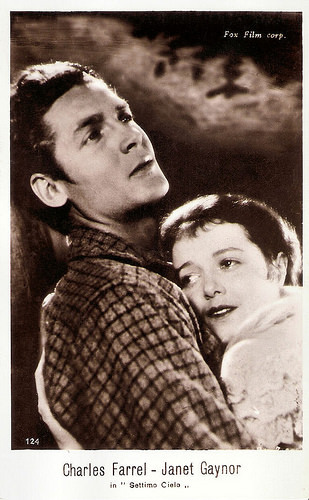
Italian postcard offered by Cioccolata Lurati, no. 124. Photo: Fox. Publicity still for Seventh Heaven (Frank Borzage, 1927) with Janet Gaynor.
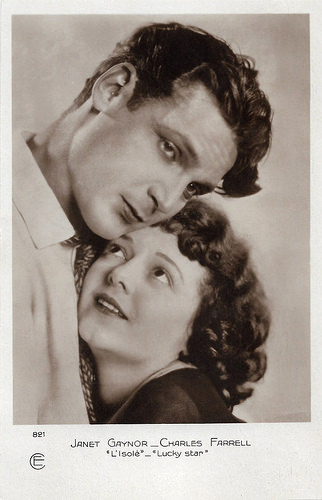
French postcard by Cinémagazine Edition (CE), Paris, no. 821. Photo: Fox. Publicity still for Lucky Star (Frank Borzage, 1929) with Janet Gaynor.
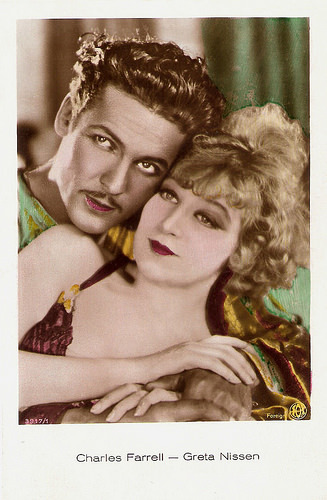
British postcard by Ross Verlag, no. 3917/1, 1928-1929. Photo: Fox. Publicity still for Fazil (Howard Hawks, 1928) with Greta Nissen .
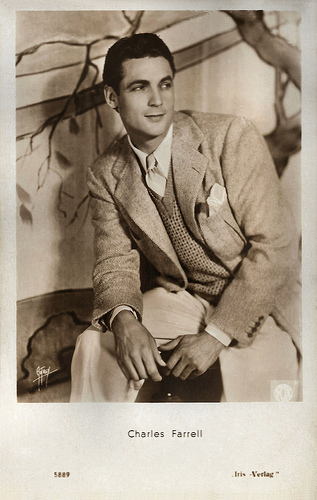
Austrian postcard by Iris-Verlag, no. 5889. Photo: Max Munn Autrey / Fox.
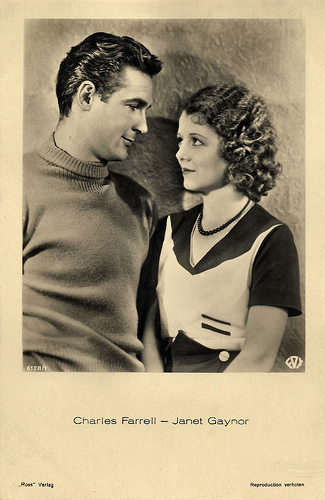
German postcard by Ross Verlag, no. 6128/1, 1931-1932. Photo: Fox. Publicity still for The First Year (William K. Howard, 1932) with Janet Gaynor .
The pivotal role as the Parisian sewer cleaner Chico
Charles David Farrell was born in 1900 in Onset, Massachusetts, the only son in his family. His father owned a lunch counter where films were shown on the upper floor which introduced Farrell to the world of cinema.
He briefly attended Boston University to study business while playing in the football team but dropped out to become an actor in the theatre. This didn’t go well with his family, especially his father, so Farrell was on his own. He took any acting job possible that would get him financially and professionally closer to his goal of being in the cinema.
The handsome young actor decided to move to California and to try his luck in Hollywood. For Paramount Pictures, Farrell did extra work for films ranging from The Hunchback of Notre Dame (Wallace Worsley, 1923) with Lon Chaney , Cecil B. DeMille's The Ten Commandments (1923), and The Cheat (George Fitzmaurice, 1923) with Pola Negri.
Farrell continued to work throughout the next few years in relatively minor roles without much success. After three years as an extra he was given a good role in Old Ironsides (James Cruze, 1926). Then his big break came when Fox Studios signed him and gave him the pivotal role as the Parisian sewer cleaner Chico in the romantic drama 7th Heaven (Frank Borzage, 1927). He was paired with fellow newcomer Janet Gaynor . The film was a public and critical success and won an Academy Award.
The studio noticed the audiences growing a craze for Farrell and Gaynor and they would go on to co-star in more than a dozen films throughout the late 1920s and into the talkie era of the early 1930s. The plots of the Gaynor-Farrell films were fit for a fairytale book where love conquers all and the good prevail, with convincing acting that makes you believe it.
Director of three of these films was Frank Borzage, known for stories set in a surreal or ethereal like world. Farrell and Gaynor were romantically involved from about 1926 until her first marriage in 1929. Shaken by the death of his close friend, actor Fred Thomson, Farrell proposed marriage to Gaynor around 1928, but the couple was never married.
Years later, Gaynor explained her breakup with Farrell: "I think we loved each other more than we were 'in love.' He played polo, he went to the Hearst Ranch for wild weekends with Marion Davies, he got around to the parties - he was a big, brawny, outdoors type... I was not a party girl... Charlie pressed me to marry him, but we had too many differences. In my era, you didn't live together. It just wasn't done. So I married a San Francisco businessman, Lydell Peck, just to get away from Charlie."
Another success for Farrell was The Red Dance (Raoul Walsh, 1928) in which Dolores del Rio co-starred as a poor girl-turned-dancer who falls in love with Farrell’s character of Grand Duke Eugene during the Bolshevik Revolution. Two months before the stock market crash, Farrell and Gaynor starred in the unique and heartfelt WWI love story, Lucky Star (Frank Borzage, 1929).
The Depression was just beginning when Farrell’s made his last and one of his best silents film, City Girl (F.W. Murnau, 1930). He plays Lem, a young man from the country sent to the city for business who falls in love with the waitress at the lunch counter named Kate (Mary Duncan). Rachel at Vintage Stardust : "His acting brought elegance even during the most emotional scenes and refreshed the image of masculinity in film even after he successfully transitioned into sound. Oh and he was one of the first to go nude in film (in The River from 1929 (sic) there’s a brief scene where he swam nude and is about to get out of the water completely before he sees a woman nearby.)" Sadly, Frank Borzage's masterpiece The River (1928) is partially lost.
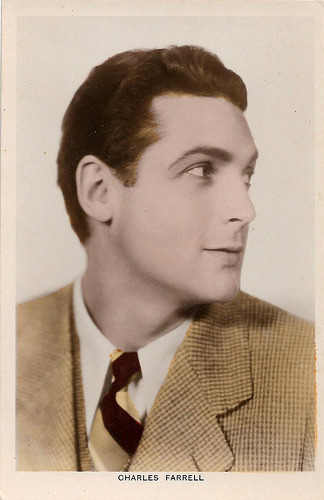
British postcard in the Colourgraph Series, London, no. C 65.
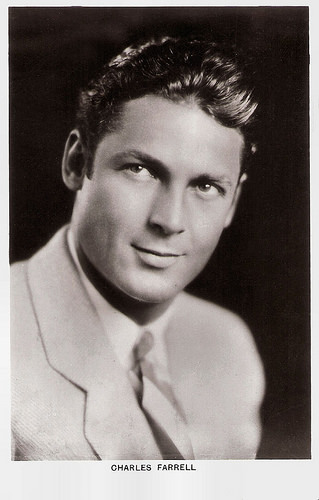
British card.
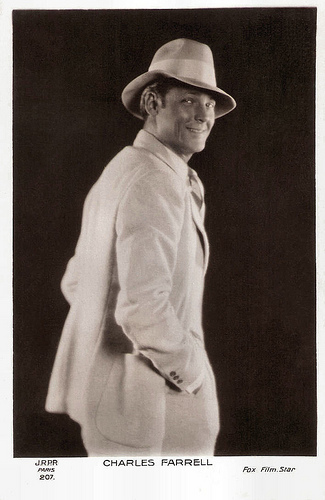
French postcard by J.R.P.R., Paris, no. 207. Photo: Fox.
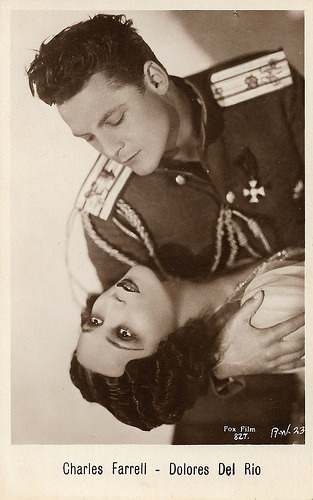
Italian postcard by G.B. Falci, Milano, no. 827. Photo: Max Munn Autrey / Fox Film. Publicity still for The Red Dance (Raoul Walsh, 1928) wirh Dolores del Rio .
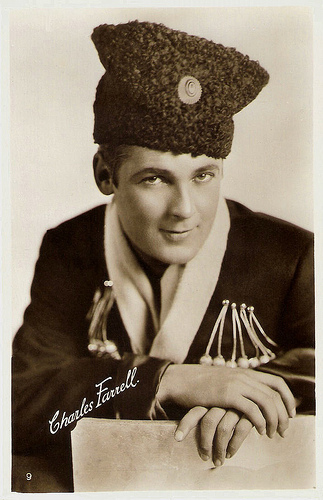
British postcard, no. 9 of a fifth series of 25 Cinema Stars, issued with Sarony Cigarettes. Photo: publicity still for The Red Dance (Raoul Walsh, 1928).
Bringing a new definition of men in cinema
Unlike many of his silent screen peers, Charles Farrell had no 'voice troubles' and remained a publicly popular actor throughout the sound era. Rachel at Vintage Stardust : "Well mannered and athletically built, Farrell’s roles were dramatic but often romantic leads that brought a new definition of men in cinema. His gentleness in his characters created the idea that men could be sensitive and kind yet strong at the same time. Not to say that men from this era couldn’t be this way in real life but to it was rare in film to depict men as being vulnerable."
In 1931 he married actress Virginia Valli, with whom he stayed together until her death in 1968. In the 1930s, Farrell became a resident of the desert city of Palm Springs, California. In 1934, he opened the popular Palm Springs Racquet Club in the city with his business partner, fellow actor Ralph Bellamy.
By the mid 1930s his career declined. Rumours point to his personal life or lack of memorable scripts. The type of leading men was also changing with the Depression. The scripts Farrell received included musicals which did not allow him to showcase his acting range. An exception was Change of Heart (John G. Blystone, 1934).
During World War II, Farrell served in the Navy. A major player in the developing prosperity of Palm Springs in the 1930s through the 1960s, Farrell was elected to the city council in 1946 and elected mayor of the community in 1948, a position that he held until he submitted his resignation in 1953 due to a return to acting.
In 1952, more than a decade after his career in motion pictures had ended, Farrell began appearing on the television series My Little Margie, which aired on CBS and NBC between 1952 and 1955. He played the role of the widower Vern Albright, the father of a young woman, Margie Albright (Gale Storm), with a knack for getting into trouble. In 1956, Farrell starred in his own television program, The Charles Farrell Show.
For the remainder of his life Farrell managed the Palm Springs Racquet Club until the late 1960s, and kept out of the Hollywood spotlight. He died of a heart attack in 1990.
At the time of his death, he felt forgotten as an actor and his films were too dated to be appreciated. But in 1990, a 35mm print of his previously considered lost film Lucky Star (1929) was discovered in the Nederlands Filmmuseum in Amsterdam. It was restored for its 1990 revival premiere at Le Giornate del Cinema Muto, the silent film festival in Pordenone, Italy. And audiences started a new craze for Farrell and Gaynor.
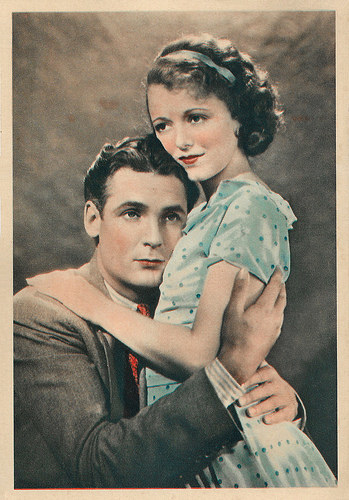
British postcard by Abdulla Cigarettes, no. 15. Photo: Fox.
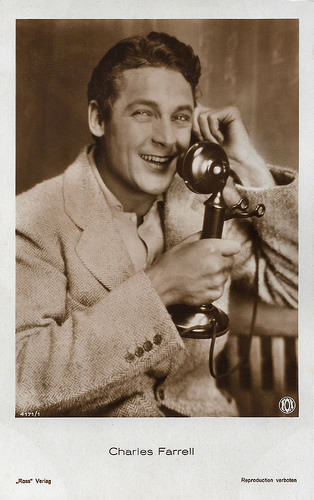
German postcard by Ross Verlag, no. 4171/1, 1929-1930. Photo: Fox.
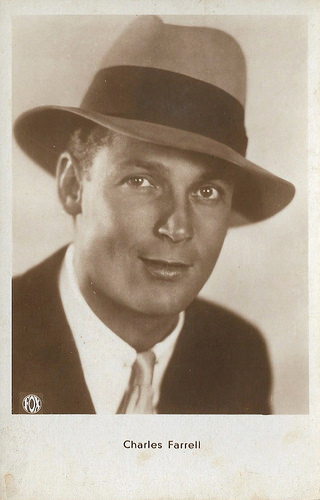
Austrian postcard by Iris Verlag, no. 5995. Photo: Fox.
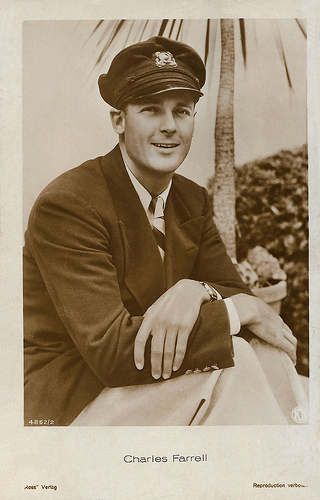
German postcard by Ross Verlag, no. 4862/2. Photo: Fox.
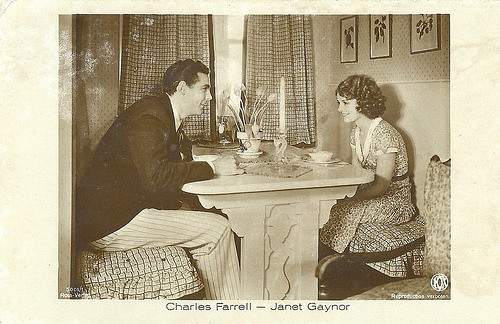
German postcard by Ross Verlag, no. 5001/1, 1930-1931. Photo: Fox. Janet Gaynor and Charles Farrell in the early sound film Sunnyside Up (David Butler, 1929).
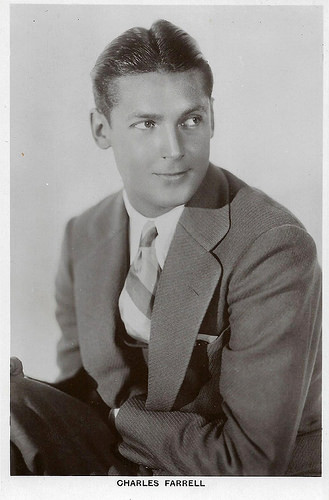
British postard in the Picturegoer series, London, no. 332.
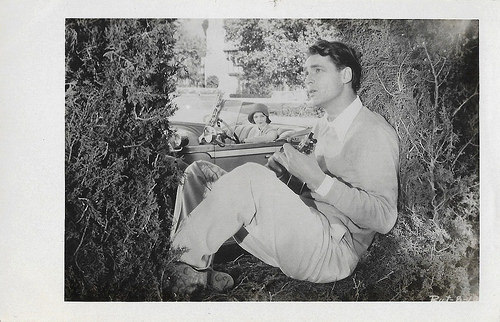
Photo postcard delivered by the Dutch East Indies. Toko Ang West, Bandoeng. Photo: publicity still for High Society Blues (David Butler, 1930).
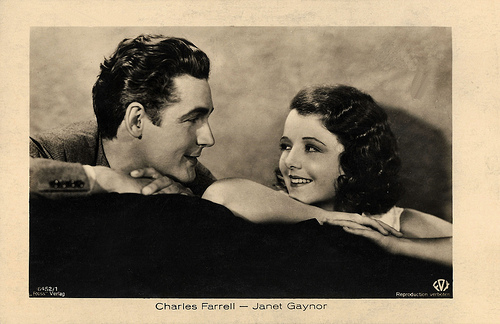
German postcard by Ross Verlag, no. 6452/1, 1931-1932. Photo: Fox. Publicity still for Delicious (David Butler, 1931) with Janet Gaynor .
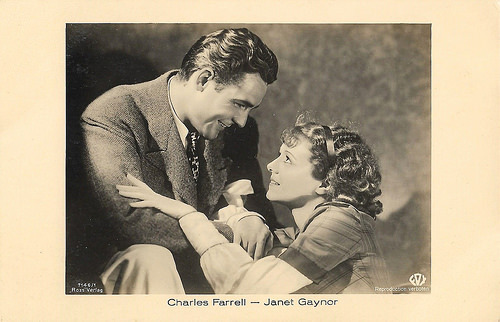
German postcard by Ross Verlag, no. 71466/1, 1932-1933. Photo: Fox. With Janet Gaynor .
Sources: Rachel (Vintage Stardust), (IMDb), (IMDb), Wikipedia and .

Italian postcard offered by Cioccolata Lurati, no. 124. Photo: Fox. Publicity still for Seventh Heaven (Frank Borzage, 1927) with Janet Gaynor.

French postcard by Cinémagazine Edition (CE), Paris, no. 821. Photo: Fox. Publicity still for Lucky Star (Frank Borzage, 1929) with Janet Gaynor.

British postcard by Ross Verlag, no. 3917/1, 1928-1929. Photo: Fox. Publicity still for Fazil (Howard Hawks, 1928) with Greta Nissen .

Austrian postcard by Iris-Verlag, no. 5889. Photo: Max Munn Autrey / Fox.

German postcard by Ross Verlag, no. 6128/1, 1931-1932. Photo: Fox. Publicity still for The First Year (William K. Howard, 1932) with Janet Gaynor .
The pivotal role as the Parisian sewer cleaner Chico
Charles David Farrell was born in 1900 in Onset, Massachusetts, the only son in his family. His father owned a lunch counter where films were shown on the upper floor which introduced Farrell to the world of cinema.
He briefly attended Boston University to study business while playing in the football team but dropped out to become an actor in the theatre. This didn’t go well with his family, especially his father, so Farrell was on his own. He took any acting job possible that would get him financially and professionally closer to his goal of being in the cinema.
The handsome young actor decided to move to California and to try his luck in Hollywood. For Paramount Pictures, Farrell did extra work for films ranging from The Hunchback of Notre Dame (Wallace Worsley, 1923) with Lon Chaney , Cecil B. DeMille's The Ten Commandments (1923), and The Cheat (George Fitzmaurice, 1923) with Pola Negri.
Farrell continued to work throughout the next few years in relatively minor roles without much success. After three years as an extra he was given a good role in Old Ironsides (James Cruze, 1926). Then his big break came when Fox Studios signed him and gave him the pivotal role as the Parisian sewer cleaner Chico in the romantic drama 7th Heaven (Frank Borzage, 1927). He was paired with fellow newcomer Janet Gaynor . The film was a public and critical success and won an Academy Award.
The studio noticed the audiences growing a craze for Farrell and Gaynor and they would go on to co-star in more than a dozen films throughout the late 1920s and into the talkie era of the early 1930s. The plots of the Gaynor-Farrell films were fit for a fairytale book where love conquers all and the good prevail, with convincing acting that makes you believe it.
Director of three of these films was Frank Borzage, known for stories set in a surreal or ethereal like world. Farrell and Gaynor were romantically involved from about 1926 until her first marriage in 1929. Shaken by the death of his close friend, actor Fred Thomson, Farrell proposed marriage to Gaynor around 1928, but the couple was never married.
Years later, Gaynor explained her breakup with Farrell: "I think we loved each other more than we were 'in love.' He played polo, he went to the Hearst Ranch for wild weekends with Marion Davies, he got around to the parties - he was a big, brawny, outdoors type... I was not a party girl... Charlie pressed me to marry him, but we had too many differences. In my era, you didn't live together. It just wasn't done. So I married a San Francisco businessman, Lydell Peck, just to get away from Charlie."
Another success for Farrell was The Red Dance (Raoul Walsh, 1928) in which Dolores del Rio co-starred as a poor girl-turned-dancer who falls in love with Farrell’s character of Grand Duke Eugene during the Bolshevik Revolution. Two months before the stock market crash, Farrell and Gaynor starred in the unique and heartfelt WWI love story, Lucky Star (Frank Borzage, 1929).
The Depression was just beginning when Farrell’s made his last and one of his best silents film, City Girl (F.W. Murnau, 1930). He plays Lem, a young man from the country sent to the city for business who falls in love with the waitress at the lunch counter named Kate (Mary Duncan). Rachel at Vintage Stardust : "His acting brought elegance even during the most emotional scenes and refreshed the image of masculinity in film even after he successfully transitioned into sound. Oh and he was one of the first to go nude in film (in The River from 1929 (sic) there’s a brief scene where he swam nude and is about to get out of the water completely before he sees a woman nearby.)" Sadly, Frank Borzage's masterpiece The River (1928) is partially lost.

British postcard in the Colourgraph Series, London, no. C 65.

British card.

French postcard by J.R.P.R., Paris, no. 207. Photo: Fox.

Italian postcard by G.B. Falci, Milano, no. 827. Photo: Max Munn Autrey / Fox Film. Publicity still for The Red Dance (Raoul Walsh, 1928) wirh Dolores del Rio .

British postcard, no. 9 of a fifth series of 25 Cinema Stars, issued with Sarony Cigarettes. Photo: publicity still for The Red Dance (Raoul Walsh, 1928).
Bringing a new definition of men in cinema
Unlike many of his silent screen peers, Charles Farrell had no 'voice troubles' and remained a publicly popular actor throughout the sound era. Rachel at Vintage Stardust : "Well mannered and athletically built, Farrell’s roles were dramatic but often romantic leads that brought a new definition of men in cinema. His gentleness in his characters created the idea that men could be sensitive and kind yet strong at the same time. Not to say that men from this era couldn’t be this way in real life but to it was rare in film to depict men as being vulnerable."
In 1931 he married actress Virginia Valli, with whom he stayed together until her death in 1968. In the 1930s, Farrell became a resident of the desert city of Palm Springs, California. In 1934, he opened the popular Palm Springs Racquet Club in the city with his business partner, fellow actor Ralph Bellamy.
By the mid 1930s his career declined. Rumours point to his personal life or lack of memorable scripts. The type of leading men was also changing with the Depression. The scripts Farrell received included musicals which did not allow him to showcase his acting range. An exception was Change of Heart (John G. Blystone, 1934).
During World War II, Farrell served in the Navy. A major player in the developing prosperity of Palm Springs in the 1930s through the 1960s, Farrell was elected to the city council in 1946 and elected mayor of the community in 1948, a position that he held until he submitted his resignation in 1953 due to a return to acting.
In 1952, more than a decade after his career in motion pictures had ended, Farrell began appearing on the television series My Little Margie, which aired on CBS and NBC between 1952 and 1955. He played the role of the widower Vern Albright, the father of a young woman, Margie Albright (Gale Storm), with a knack for getting into trouble. In 1956, Farrell starred in his own television program, The Charles Farrell Show.
For the remainder of his life Farrell managed the Palm Springs Racquet Club until the late 1960s, and kept out of the Hollywood spotlight. He died of a heart attack in 1990.
At the time of his death, he felt forgotten as an actor and his films were too dated to be appreciated. But in 1990, a 35mm print of his previously considered lost film Lucky Star (1929) was discovered in the Nederlands Filmmuseum in Amsterdam. It was restored for its 1990 revival premiere at Le Giornate del Cinema Muto, the silent film festival in Pordenone, Italy. And audiences started a new craze for Farrell and Gaynor.

British postcard by Abdulla Cigarettes, no. 15. Photo: Fox.

German postcard by Ross Verlag, no. 4171/1, 1929-1930. Photo: Fox.

Austrian postcard by Iris Verlag, no. 5995. Photo: Fox.

German postcard by Ross Verlag, no. 4862/2. Photo: Fox.

German postcard by Ross Verlag, no. 5001/1, 1930-1931. Photo: Fox. Janet Gaynor and Charles Farrell in the early sound film Sunnyside Up (David Butler, 1929).

British postard in the Picturegoer series, London, no. 332.

Photo postcard delivered by the Dutch East Indies. Toko Ang West, Bandoeng. Photo: publicity still for High Society Blues (David Butler, 1930).

German postcard by Ross Verlag, no. 6452/1, 1931-1932. Photo: Fox. Publicity still for Delicious (David Butler, 1931) with Janet Gaynor .

German postcard by Ross Verlag, no. 71466/1, 1932-1933. Photo: Fox. With Janet Gaynor .
Sources: Rachel (Vintage Stardust), (IMDb), (IMDb), Wikipedia and .
Published on November 01, 2018 23:00
October 31, 2018
My Fair Lady (1964)
Today, EFSP starts two months of posts with European postcards for Hollywood film stars and/or films. Thursday is the day for the film specials, and our first movie is special!
My Fair Lady (George Cukor, 1964) is one of the all-time great movie musicals, featuring classic songs by Alan Jay Lerner and Frederick Loewe and the wonderful costumes by Cecil Beaton. The film won eight Oscars, including Best Picture, Best Director and Best Actor for Rex Harrison in his legendary performance as misanthropic phonetics professor Henry Higgins. But Audrey Hepburn failed to be nominated for Best Actress. The Oscar was won by Julie Andrews for Mary Poppins, in what many observers saw as a backlash against Andrews' not being cast in the film after originating the role of Eliza on stage.
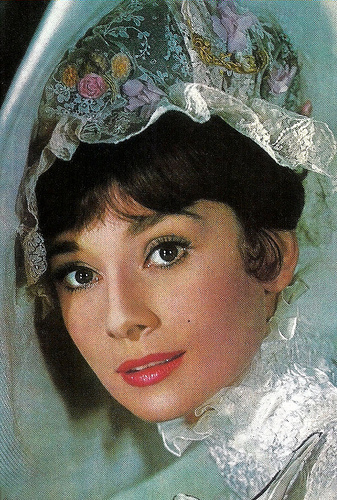
Spanish postcard by Oscarcolor. Photo: Audrey Hepburn in My Fair Lady (George Cukor, 1964).
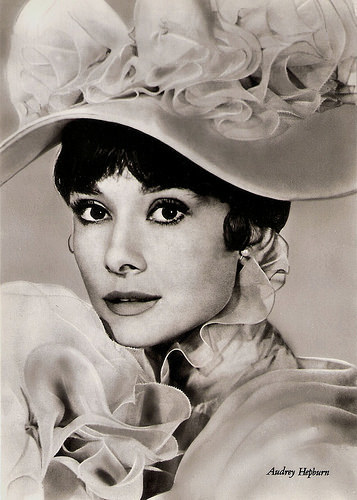
East-German postcard by VEB-Progress Film-Vertrieb, Berlin, no. 2988. Retail price: 0,20 MDM. Photo: Warner Bros. Publicity still for My Fair Lady (George Cukor, 1964). Costume: Cecil Beaton.
The delusive dream of a man forming his own perfect woman
My Fair Lady was adapted by Alan Jay Lerner and Frederick Loewe as a stage musical from the the 1913 brilliant stage play Pygmalion by George Bernard Shaw about the delusive dream of a man forming his own perfect woman.
In Edwardian London, Professor Henry Higgins, a scholar of phonetics, believes that the accent and tone of one's voice determines a person's prospects in society. Outside Covent Garden on a rainy evening in 1912, he boasts to a new acquaintance, Colonel Hugh Pickering, himself an expert in phonetics, that he could teach any person to speak in a way that he could pass them off as a duke or duchess at an embassy ball.
Higgins selects as an example a young flower girl, Eliza Doolittle, who has a strong Cockney accent. Higgins tells Pickering that, within six months, he could transform Eliza into a proper lady, simply by teaching her proper English.
Eliza's ambition is to work in a flower shop, but her thick accent makes her unsuitable. Having come from India to meet Higgins, Pickering is invited to stay with the professor. The following morning, face and hands freshly scrubbed, Eliza shows up at Higgins' home, offering to pay him to teach her to be a lady. Pickering is intrigued and offers to cover all expenses, should the experiment be successful.
My Fair Lady became the longest-running Broadway musical with in the leads Rex Harrison as Henry and Julie Andrews as Eliza. With the same cast, the musical also became a huge success in London. Alan Jay Lerner and Frederick Loewe made a great musical score. Most of their songs would become standards over the years that delighted audiences all over the world.
However, when Hollywood producer Jack Warner decided to make a film version of the hit musical, he felt that Andrews, at the time unknown beyond Broadway, wasn't bankable. He replaced her with Audrey Hepburn , a wonderful film actress but not a real singer. Hepburn's singing was dubbed by Marni Nixon, who had dubbed Natalie Wood in West Side Story (1961). Supporting roles went to Stanley Holloway (as Eliza's father, dustman Afred P. Doolittle), Gladys Cooper (Henry's mother Mrs. Higgins), Wilfrid Hyde-White (Colonel Pickering) and Jeremy Brett as the young playboy Freddy.
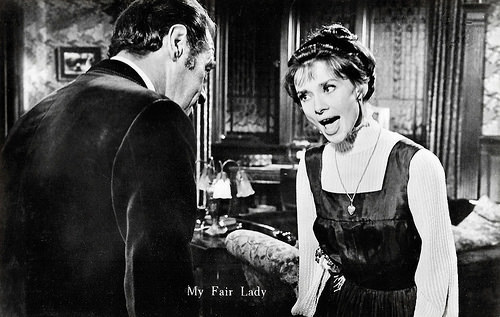
Dutch postcard by Int. Filmpers, Amsterdam, no. 1306. Photo: Warner Bros. Rex Harrison and Audrey Hepburn in My Fair Lady (George Cukor, 1964).
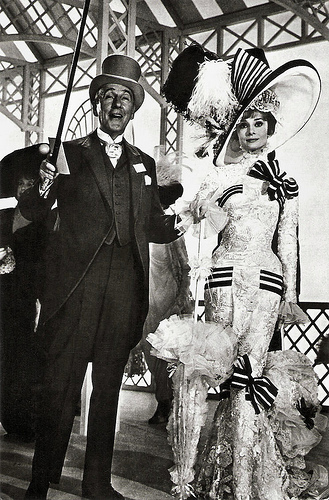
Romanian postcard by Casa Filmului Acin, no. 261. Wilfrid Hyde-White and Audrey Hepburn in My Fair Lady (George Cukor, 1964).
How could Eliza be played by anyone else than Julie Andrews?
With a production budget of $17 million, My Fair Lady became the most expensive film shot in the United States up to that time. George Cukor created an elegant, colourful adaptation of the beloved stage musical and Rex Harrison did another winning performance. But how did Audrey Hepburn ? The move to choose her over Julie Andrews had puzzled many in the theatrical world. How could Eliza be played by anyone else than Andrews?
Hepburn played the unschooled street urchin with a sweet, naive charm. Eliza goes through many forms of speech training, such as speaking with marbles in her mouth, enduring Higgins' harsh approach to teaching and his treatment of her personally. She makes little progress, but just as she, Higgins, and Pickering are about to give up, Eliza finally 'gets it'; she instantly begins to speak with an impeccable upper class accent. As the elegant and beautiful lady at the end of the film, Hepburn literally glows in the exquisite costumes designed for her by Cecil Beaton. She is a perfect match to Harrison's Higgins.
Ephraim Gadsby at IMDb: "The old furors over Audrey Hepburn seem silly in hindsight. Hepburn replaced Julie Andrews, a wonderful singer-actress who had created the role, not only on Broadway but in London. But Andrews was not a familiar face to movie-goers and no one knew if she'd hold an audience in the movies as in the live theaters. Too, Hepburn was an inspired choice, since her background probably would make Eliza Doolittle's transformation from flower-selling gutter-snipe into a lady of quality more believable (Hepburn's mother was a baroness)."
Richard Gilliam in his review at AllMovie: "Exquisitely produced by Warner Bros, it represents the zenith of the movie musical as an art form and as popular entertainment. Rex Harrison leads an impeccable cast, and, yes, that's Marni Nixon singing for Audrey Hepburn , but Hepburn is perfectly cast otherwise. The major star of the film is perhaps set designer/costume designer Cecil Beaton, whose visual contributions immediately impacted European and U.S. fashion trends."
In 1998, the American Film Institute named My Fair Lady (1964) the 91st greatest American film of all time. Critic Roger Ebert put the film on his 'Great Movies' list: "My Fair Lady is the best and most unlikely of musicals, during which I cannot decide if I am happier when the characters are talking or when they are singing. The songs are literate and beloved; some romantic, some comic, some nonsense, some surprisingly philosophical, every single one wonderful."
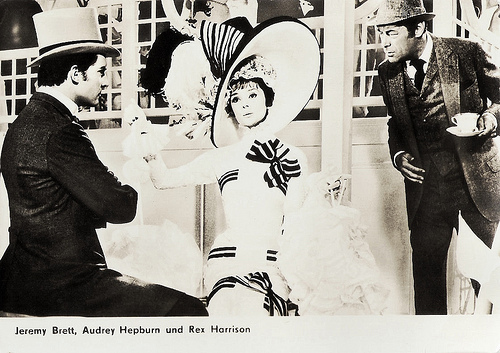
East-German postcard by VEB-Progress Film-Vertrieb, Berlin, no. 2989. Retail price: 0,20 MDM. Photo: Warner Bros. Publicity still for My Fair Lady (George Cukor, 1964) with Audrey Hepburn , Jeremy Brett and Rex Harrison .
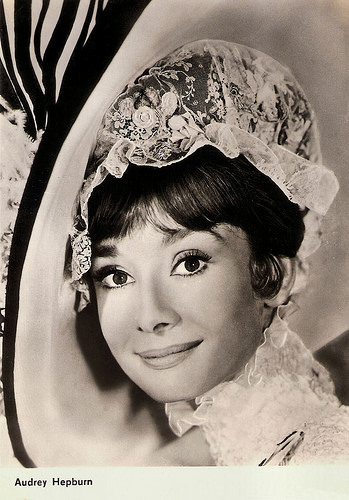
East-German postcard by VEB-Progress Film-Vertrieb, Berlin, no. 3028. Retail price: 0,20 MDM. Photo: Warner Bros. Publicity still for My Fair Lady (George Cukor, 1964).
Trailer My Fair Lady (1964). Source: YouTube (ManUtd1962).
Sources: Roger Ebert, Hal Erickson (AllMovie), Richard Gilliam (AllMovie), Ephraim Gadsby (IMDb), Dennis Littrell (IMDb), Wikipedia and IMDb.
My Fair Lady (George Cukor, 1964) is one of the all-time great movie musicals, featuring classic songs by Alan Jay Lerner and Frederick Loewe and the wonderful costumes by Cecil Beaton. The film won eight Oscars, including Best Picture, Best Director and Best Actor for Rex Harrison in his legendary performance as misanthropic phonetics professor Henry Higgins. But Audrey Hepburn failed to be nominated for Best Actress. The Oscar was won by Julie Andrews for Mary Poppins, in what many observers saw as a backlash against Andrews' not being cast in the film after originating the role of Eliza on stage.

Spanish postcard by Oscarcolor. Photo: Audrey Hepburn in My Fair Lady (George Cukor, 1964).

East-German postcard by VEB-Progress Film-Vertrieb, Berlin, no. 2988. Retail price: 0,20 MDM. Photo: Warner Bros. Publicity still for My Fair Lady (George Cukor, 1964). Costume: Cecil Beaton.
The delusive dream of a man forming his own perfect woman
My Fair Lady was adapted by Alan Jay Lerner and Frederick Loewe as a stage musical from the the 1913 brilliant stage play Pygmalion by George Bernard Shaw about the delusive dream of a man forming his own perfect woman.
In Edwardian London, Professor Henry Higgins, a scholar of phonetics, believes that the accent and tone of one's voice determines a person's prospects in society. Outside Covent Garden on a rainy evening in 1912, he boasts to a new acquaintance, Colonel Hugh Pickering, himself an expert in phonetics, that he could teach any person to speak in a way that he could pass them off as a duke or duchess at an embassy ball.
Higgins selects as an example a young flower girl, Eliza Doolittle, who has a strong Cockney accent. Higgins tells Pickering that, within six months, he could transform Eliza into a proper lady, simply by teaching her proper English.
Eliza's ambition is to work in a flower shop, but her thick accent makes her unsuitable. Having come from India to meet Higgins, Pickering is invited to stay with the professor. The following morning, face and hands freshly scrubbed, Eliza shows up at Higgins' home, offering to pay him to teach her to be a lady. Pickering is intrigued and offers to cover all expenses, should the experiment be successful.
My Fair Lady became the longest-running Broadway musical with in the leads Rex Harrison as Henry and Julie Andrews as Eliza. With the same cast, the musical also became a huge success in London. Alan Jay Lerner and Frederick Loewe made a great musical score. Most of their songs would become standards over the years that delighted audiences all over the world.
However, when Hollywood producer Jack Warner decided to make a film version of the hit musical, he felt that Andrews, at the time unknown beyond Broadway, wasn't bankable. He replaced her with Audrey Hepburn , a wonderful film actress but not a real singer. Hepburn's singing was dubbed by Marni Nixon, who had dubbed Natalie Wood in West Side Story (1961). Supporting roles went to Stanley Holloway (as Eliza's father, dustman Afred P. Doolittle), Gladys Cooper (Henry's mother Mrs. Higgins), Wilfrid Hyde-White (Colonel Pickering) and Jeremy Brett as the young playboy Freddy.

Dutch postcard by Int. Filmpers, Amsterdam, no. 1306. Photo: Warner Bros. Rex Harrison and Audrey Hepburn in My Fair Lady (George Cukor, 1964).

Romanian postcard by Casa Filmului Acin, no. 261. Wilfrid Hyde-White and Audrey Hepburn in My Fair Lady (George Cukor, 1964).
How could Eliza be played by anyone else than Julie Andrews?
With a production budget of $17 million, My Fair Lady became the most expensive film shot in the United States up to that time. George Cukor created an elegant, colourful adaptation of the beloved stage musical and Rex Harrison did another winning performance. But how did Audrey Hepburn ? The move to choose her over Julie Andrews had puzzled many in the theatrical world. How could Eliza be played by anyone else than Andrews?
Hepburn played the unschooled street urchin with a sweet, naive charm. Eliza goes through many forms of speech training, such as speaking with marbles in her mouth, enduring Higgins' harsh approach to teaching and his treatment of her personally. She makes little progress, but just as she, Higgins, and Pickering are about to give up, Eliza finally 'gets it'; she instantly begins to speak with an impeccable upper class accent. As the elegant and beautiful lady at the end of the film, Hepburn literally glows in the exquisite costumes designed for her by Cecil Beaton. She is a perfect match to Harrison's Higgins.
Ephraim Gadsby at IMDb: "The old furors over Audrey Hepburn seem silly in hindsight. Hepburn replaced Julie Andrews, a wonderful singer-actress who had created the role, not only on Broadway but in London. But Andrews was not a familiar face to movie-goers and no one knew if she'd hold an audience in the movies as in the live theaters. Too, Hepburn was an inspired choice, since her background probably would make Eliza Doolittle's transformation from flower-selling gutter-snipe into a lady of quality more believable (Hepburn's mother was a baroness)."
Richard Gilliam in his review at AllMovie: "Exquisitely produced by Warner Bros, it represents the zenith of the movie musical as an art form and as popular entertainment. Rex Harrison leads an impeccable cast, and, yes, that's Marni Nixon singing for Audrey Hepburn , but Hepburn is perfectly cast otherwise. The major star of the film is perhaps set designer/costume designer Cecil Beaton, whose visual contributions immediately impacted European and U.S. fashion trends."
In 1998, the American Film Institute named My Fair Lady (1964) the 91st greatest American film of all time. Critic Roger Ebert put the film on his 'Great Movies' list: "My Fair Lady is the best and most unlikely of musicals, during which I cannot decide if I am happier when the characters are talking or when they are singing. The songs are literate and beloved; some romantic, some comic, some nonsense, some surprisingly philosophical, every single one wonderful."

East-German postcard by VEB-Progress Film-Vertrieb, Berlin, no. 2989. Retail price: 0,20 MDM. Photo: Warner Bros. Publicity still for My Fair Lady (George Cukor, 1964) with Audrey Hepburn , Jeremy Brett and Rex Harrison .

East-German postcard by VEB-Progress Film-Vertrieb, Berlin, no. 3028. Retail price: 0,20 MDM. Photo: Warner Bros. Publicity still for My Fair Lady (George Cukor, 1964).
Trailer My Fair Lady (1964). Source: YouTube (ManUtd1962).
Sources: Roger Ebert, Hal Erickson (AllMovie), Richard Gilliam (AllMovie), Ephraim Gadsby (IMDb), Dennis Littrell (IMDb), Wikipedia and IMDb.
Published on October 31, 2018 23:00
October 30, 2018
Jean Gabin
French actor and war hero Jean Gabin (1904-1976) was one of the greatest stars of the European cinema. In the 1930s he became the personification of the tragic romantic hero of the poetic realist film. Whether he played the legionnaire (Gueule d'amour), the deserter (Le Quai des brumes) or the head gangster (Pépé le Moko), Gabin was impeccable, bringing a tragic humanity to each of his appearances which the public adored. After the war Gabin was reborn as a tough anti-hero, set in his beliefs, feared and respected by all, the Godfather of French cinema.
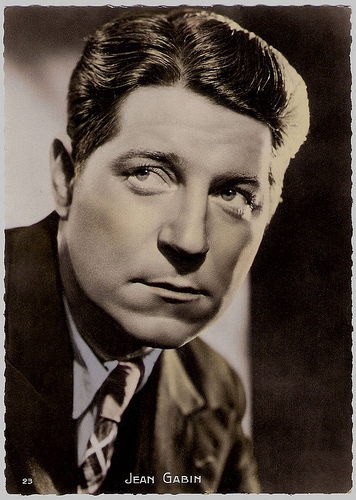
French postcard by Editions P.I., Paris, no. 23.

French postcard by Editions O.P., Paris, no. 29. Photo: Star. Publicity still for Gueule d'amour/Madeleine (Jean Grémillon, 1937).

French postcard by A.N., Paris, no. 1160. Photo: Films Osso. Publicity still for Le quai des brumes/Port of Shadows (Marcel Carne, 1938).
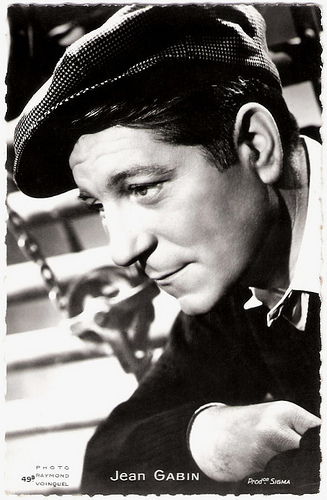
French postcard by Edit. Chantal, Rueil (S.-O.), no, 49B. Photo: Raymond Voinquel / Sigma. Publicity still for Le jour se lève/Daybreak (Marcel Carne, 1939).
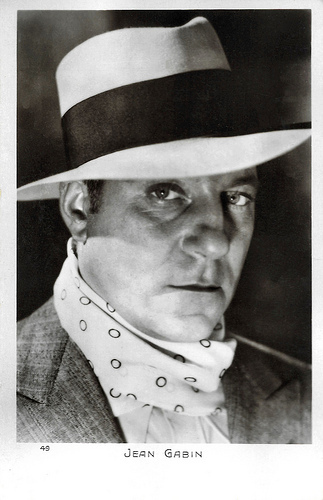
French postcard by Edition Chantal, Paris, no. 49.

French collectors card by Massilia.
From Bottom To Top
Jean Gabin was born Jean-Alexis Gabin Moncorgé in Paris, in 1904. He grew up in the village of Mériel in the Seine-et-Oise département, about 35 km north of Paris. His parents, Ferdinand Moncorgé and Hélène Petit, were entertainers, who performed in local cafés.
Jean worked as a labourer, but from an early age, entertainment was in his blood. At 18, he took a turn at the Folies-Bergère. He then appeared in revues and operettas, singing and dancing, and becoming famous for his imitation of Maurice Chevalier .
Through a chance meeting with the singer Mistinguett in 1928, he was given a spot at the Moulin-Rouge. This led to uncredited parts in two silent sketch films Ohé! Les valises/Hey! Suitcases (1928) and Les Lions/The Lions (1928) with the comic Raymond Dandy.
Two years later, he easily made the transition to sound film in the Pathé Frères production Chacun sa Chance/Everyone a chance (René Pujol, Hans Steinhoff, 1930). In this film he appeared with Gaby Basset, whom he had married in 1927.
Gabin made more than a dozen films over the next four years, including Méphisto (Henri Debain, Georges Vinter, 1930), Tout ça ne vaut pas l'amour/While it's not worth the love (Jacques Tourneur, 1931), Coeur de lilas/Lilac (Anatole Litvak, 1932), Les gaietés de l'escadron/Fun in Barracks (Maurice Tourneur, 1932), La Foule hurle (John Daumery, Howard Hawks, 1932) and Du haut en bas/From Top to Bottom (Georg Wilhelm Pabst, 1933).
He gained real recognition for his performance in Maria Chapdelaine (Julien Duvivier, 1934) starring Madeleine Renaud . Cast as a romantic hero opposite Annabella in the war drama La Bandera/Escape from Yesterday (Julien Duvivier, 1936) established Gabin as a major star.
He teamed up with Julien Duvivier again, this time in La belle équipe/They Were Five (1936) and in the highly successful Pépé le Moko (1937) that became one of the top grossing films of 1937 worldwide. Its popularity brought Gabin international recognition.
That same year, he starred in the masterpiece La grande Illusion/The Grand Illusion (Jean Renoir, 1937) an anti-war film that was a huge box office success and given universal critical acclaim, even running at a New York City theatre for an unprecedented six months.
This was followed by another one of Renoir's great successes: La bête humaine/The Human Beast (Jean Renoir, 1938), a Film Noir tragedy based on the novel by Émile Zola and starring Gabin and Simone Simon , as well as Le quai des brumes/Port of Shadows (1938) and Le jour se lève/Daybreak (1939) with Arletty , two of director Marcel Carné's most acclaimed films.

French postcard by A.N., Paris, no. 692. Photo: Film Pathé-Natan. Publicity still for Chacun sa chance/Everyone a chance (René Pujol, Hans Steinhoff, 1930).

French postcard by Edition Chantal, Paris, no. 49. Photo: Pathé-Consortium.

French postcard, no. 49. Photo: publicity still for La Bandera (Julien Duvivier, 1935).

French postcard by Erpé, no. 567. Photo: Film ACE, Paris. Publicity still for Gueule d'amour/Madeleine (Jean Grémillon, 1937).

French postcard by Crépa, Editeur, Paris. Photo: Sam Lévin. Publicity still for La grande illusion/The Grand Illusion (Jean Renoir, 1937) with Jean Gabin, Dalio , Julien Carette, Gaston Modot and Pierre Fresnay .

French postcard by Edit. Chantal, Rueil, no. 49B.

French postcard by Viny, no. 12. Photo: Paris Film.
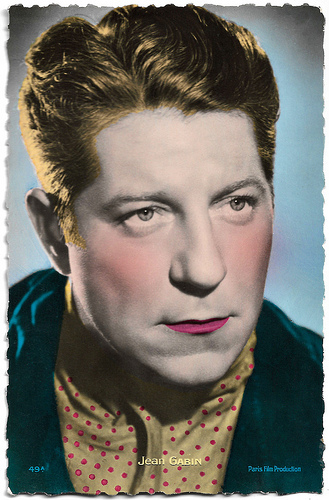
French postcard by edition Chantal, Paris, no. 49A. Photo: Paris Film Production.
Marlene
Jean Gabin was flooded with offers from Hollywood. For a time he turned them all down until the outbreak of World War II. Following the German occupation of France, he joined Jean Renoir and Julien Duvivier in the United States.
He had divorced his second wife Suzanne Mauchain in 1939, and during his time in Hollywood, Gabin began a torrid romance with film star Marlene Dietrich .
His Hollywood film career proved to be less successful: he made two films, Moon Tide (Archie Mayo, 1942) and The Impostor (Julien Duvivier, 1944), both of which were flops. Scheduled to star in an RKO film, at the last minute he demanded Dietrich be given the co-starring role. The studio refused. After Gabin remained steadfast in his demand, he was fired, and the film project was shelved.
Undaunted, he enlisted in 1943 as a tank commander in the Forces françaises libres. He earned the Médaille Militaire and a Croix de Guerre for his wartime valour fighting with the Allies in North Africa. Following D-Day, Gabin was part of the military contingent that entered a liberated Paris. Captured on film by the media is a scene where an anxious Marlene Dietrich is waiting in the crowd when she spots Gabin onboard a battle tank and rushes to him.
In 1946, Gabin was hired by Marcel Carné to star in the film, Les Portes de la Nuit/Gates of the Night, but his conduct got him fired again. He then found a French producer and director willing to cast him and Marlene Dietrich together in the box office success Martin Roumagnac/The Room Upstairs (Georges Lacombe, 1946), but their personal relationship soon ended.
After the box office failure of Miroir/Mirror (Raymond Lamy, 1947) Gabin returned to the stage, but there too, the production was a financial disaster. He was cast in the lead role of Au-Delà Des Grilles/The Walls of Malapaga (René Clément, 1949) that won the Academy Award for Best Foreign Language Film. Despite this recognition, the film did not do well at the French box office, and the next five years brought little more than repeated box office failures.

French postcard by S.E.R.P., Paris, no. 135. Photo: Studio Harcourt.

French postcard by S.E.R.P., Paris, no. 22. Photo: Studio Harcourt.
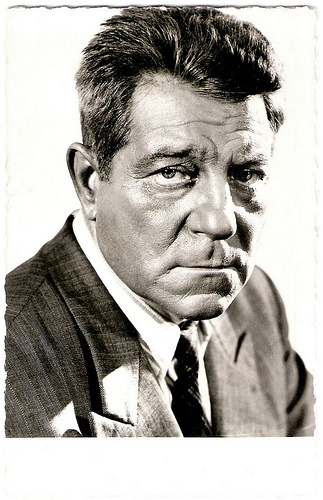
French postcard by Editions P.I., Paris, no. 1094. Offered by Les Carbones Korès 'Carboplane'. Photo: Marcel Bougureau.

Dutch postcard by Gebr. Spanjersberg N.V., Rotterdam, Dutch licence holder for Universum-Film Aktiengesellschaft, Berlin-Templehof, no. 1501. Photo: Serge Beauvarlet / Franco London Film, Paris. Publicity still for French Cancan (Jean Renoir, 1954) with Maria Félix .

Dutch postcard by Gebr. Spanjersberg N.V., Rotterdam, no. 2042. Photo: Pallas Film. Publicity still for Chiens perdus sans collier/The Little Rebels (Jean Delannoy, 1955).
Lemon Prize
Jean Gabin's career seemed headed for oblivion. In 1953 he was the male winner of the Lemon Prize, awarded by French journalists to the nastiest French actors. However, he made a comeback in the classic policier Touchez pas au grisbi/Don't Touch the Loot (Jacques Becker, 1954) with René Dary . His performance earned him critical acclaim, and the film was a very profitable international success.
Later, he worked once again with Jean Renoir on French Cancan (1955), with María Félix and Françoise Arnoul . Over the next twenty years, Gabin made close to 50 more films, most of them very successful commercially and critically, including many for Gafer Films, his production partnership with fellow actor Fernandel .
One of his most popular personalities was inspector Maigret from the detective novels by Georges Simenon in Maigret tend un piège/Maigret Sets a Trap (Jean Delannoy, 1958) and Maigret et l'affaire Saint-Fiacre/Maigret and the St. Fiacre Case (Jean Delannoy, 1959). But he was also able to play all other kind of people: aristocrats, farmers, thieves and managers.
With age, a new Gabin persona emerged, more solid, more self-assured, yet always human. His co-stars included French cinema stars as his good friend Lino Ventura in Razzia sur la Chnouf/Razzia (Henri Decoin, 1955), Bourvil in La traversée de Paris/The Trip Across Paris (Claude Autant-Lara, 1956), Brigitte Bardot in En cas de malheur/In Case of Adversity (Claude Autant-Lara, 1958), Jean-Paul Belmondo in Un singe en hiver/A Monkey in Winter (Henri Verneuil, 1962), Simone Signoret in Le Chat/The Cat (Pierre Granier-Deferre, 1971), and Alain Delon in Mélodie en sous-sol/Any Number Can Win (Henri Verneuil, 1963), Le Clan des Siciliens/The Sicilian Clan (Henri Verneuil, 1969), and Deux hommes dans la ville/Two Men in Town (José Giovanni, 1973).
In 1960 Gabin was made an Officier de la Légion d'honneur (officer of France's Legion of Honor). Gabin never stopped working and when death surprised him in 1976 he was still an institution for the French audience. His last film was the comedy L'Année sainte/Holy Year (Jean Girault, 1976).
Jean Gabin died in 1976 of a heart attack in the Parisian suburb of Neuilly-sur-Seine. His body was cremated and with full military honours, his ashes were dispersed into the sea from the military ship Détroyat.
Since 1949, he had been married to Dominique Fournier, who had been a mannequin for couturier Lanvin. They had three children, Valérie Moncorgé, Florence Moncorgé and Mathias Moncorgé. He had bought a sprawling farm in Normandy, and was as contented in his life as the country farmer as he was acting in front of a film camera. The Musée Jean Gabin in his native town, Mériel, contains his story and features his war and film memorabilia.
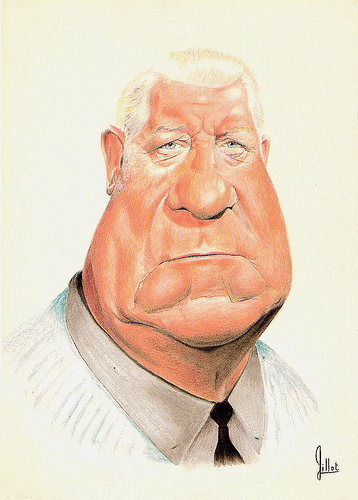
French postcard by Editions et Impressions Combier, Mâcon, no. 3. Illustration: Jean-Pierre Gillot.
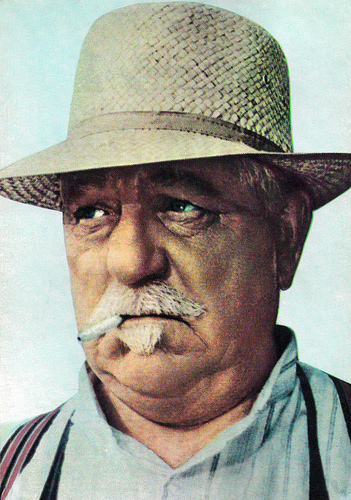
Romanian postcard by Casa Filmului Acin. Photo: publicity still for Le jardinier d'Argenteuil/The Gardener of Argenteuil (Jean-Paul Le Chanois, 1966).

French postcard by Editions Hazan, Paris, 1991, no. 6251. Photo: publicity still for Le cave se rebiffe/Money Money Money (Gilles Grangier, 1961) with Bernard Blier .

Czech collectors card by Pressfoto, Praha (Prague), no. S 125/6, 1966. Publicity still for Un Singe en Hiver/A Monkey in Winter (Henri Verneuil, 1962) with Jean-Paul Belmondo .
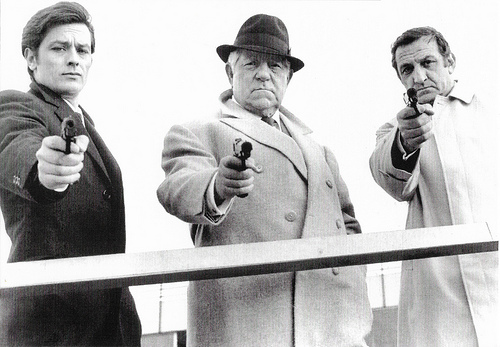
French postcard by Finart-Print (DR), no. 304. Photo: publicity still for Le clan des Siciliens/The Sicilian Clan (Henri Verneuil, 1969) with Alain Delon , Jean Gabin and Lino Ventura .
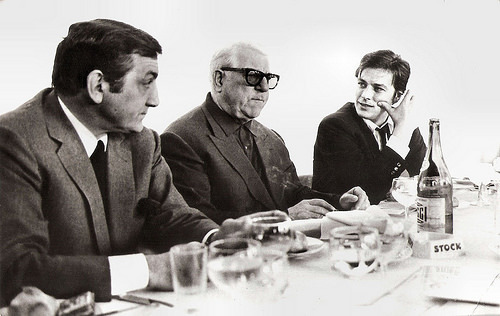
Romanian postcard by Cas Filmului Acin, no. 436. Photo: publicity still for Le clan des Siciliens/The Sicilian Clan (Henri Verneuil, 1969) with Lino Ventura and Alain Delon .

East-German postcard by VEB Progress Film-Vertrieb, no. 152/72. Photo: Unifrance Film. Publicity still for Le soleil des voyous/Leather and Nylon (Jean Delannoy, 1967).
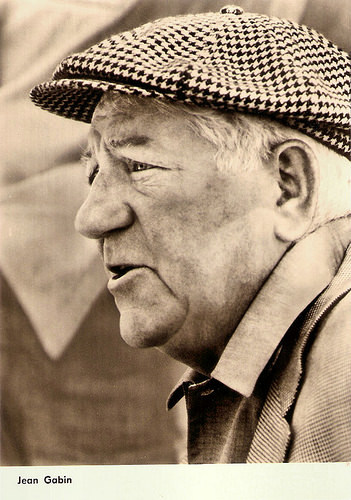
East-German postcard by VEB Progress Film-Vertrieb, no. 2917, 1967. Photo: Unifrance Film. Publicity still for Le soleil des voyous/Leather and Nylon (Jean Delannoy, 1967).
Trailer Pépé le Moko (1937). Source: neondreams 25 (YouTube).
Trailer La grande Illusion/The Grand Illusion (1937). Source: Danios 12345 (YouTube).
Trailer for French Cancan (1955). Source: BFI Trailers (YouTube).
Trailer En Cas de Malheur (1958). Source: films7story (YouTube).
Trailer Le clan des Siciliens/The Sicilian Clan (1969). Source: Dicfish (YouTube).
Sources: James Travers (Films de France), (IMDb), Wikipedia, and .

French postcard by Editions P.I., Paris, no. 23.

French postcard by Editions O.P., Paris, no. 29. Photo: Star. Publicity still for Gueule d'amour/Madeleine (Jean Grémillon, 1937).

French postcard by A.N., Paris, no. 1160. Photo: Films Osso. Publicity still for Le quai des brumes/Port of Shadows (Marcel Carne, 1938).

French postcard by Edit. Chantal, Rueil (S.-O.), no, 49B. Photo: Raymond Voinquel / Sigma. Publicity still for Le jour se lève/Daybreak (Marcel Carne, 1939).

French postcard by Edition Chantal, Paris, no. 49.

French collectors card by Massilia.
From Bottom To Top
Jean Gabin was born Jean-Alexis Gabin Moncorgé in Paris, in 1904. He grew up in the village of Mériel in the Seine-et-Oise département, about 35 km north of Paris. His parents, Ferdinand Moncorgé and Hélène Petit, were entertainers, who performed in local cafés.
Jean worked as a labourer, but from an early age, entertainment was in his blood. At 18, he took a turn at the Folies-Bergère. He then appeared in revues and operettas, singing and dancing, and becoming famous for his imitation of Maurice Chevalier .
Through a chance meeting with the singer Mistinguett in 1928, he was given a spot at the Moulin-Rouge. This led to uncredited parts in two silent sketch films Ohé! Les valises/Hey! Suitcases (1928) and Les Lions/The Lions (1928) with the comic Raymond Dandy.
Two years later, he easily made the transition to sound film in the Pathé Frères production Chacun sa Chance/Everyone a chance (René Pujol, Hans Steinhoff, 1930). In this film he appeared with Gaby Basset, whom he had married in 1927.
Gabin made more than a dozen films over the next four years, including Méphisto (Henri Debain, Georges Vinter, 1930), Tout ça ne vaut pas l'amour/While it's not worth the love (Jacques Tourneur, 1931), Coeur de lilas/Lilac (Anatole Litvak, 1932), Les gaietés de l'escadron/Fun in Barracks (Maurice Tourneur, 1932), La Foule hurle (John Daumery, Howard Hawks, 1932) and Du haut en bas/From Top to Bottom (Georg Wilhelm Pabst, 1933).
He gained real recognition for his performance in Maria Chapdelaine (Julien Duvivier, 1934) starring Madeleine Renaud . Cast as a romantic hero opposite Annabella in the war drama La Bandera/Escape from Yesterday (Julien Duvivier, 1936) established Gabin as a major star.
He teamed up with Julien Duvivier again, this time in La belle équipe/They Were Five (1936) and in the highly successful Pépé le Moko (1937) that became one of the top grossing films of 1937 worldwide. Its popularity brought Gabin international recognition.
That same year, he starred in the masterpiece La grande Illusion/The Grand Illusion (Jean Renoir, 1937) an anti-war film that was a huge box office success and given universal critical acclaim, even running at a New York City theatre for an unprecedented six months.
This was followed by another one of Renoir's great successes: La bête humaine/The Human Beast (Jean Renoir, 1938), a Film Noir tragedy based on the novel by Émile Zola and starring Gabin and Simone Simon , as well as Le quai des brumes/Port of Shadows (1938) and Le jour se lève/Daybreak (1939) with Arletty , two of director Marcel Carné's most acclaimed films.

French postcard by A.N., Paris, no. 692. Photo: Film Pathé-Natan. Publicity still for Chacun sa chance/Everyone a chance (René Pujol, Hans Steinhoff, 1930).

French postcard by Edition Chantal, Paris, no. 49. Photo: Pathé-Consortium.

French postcard, no. 49. Photo: publicity still for La Bandera (Julien Duvivier, 1935).

French postcard by Erpé, no. 567. Photo: Film ACE, Paris. Publicity still for Gueule d'amour/Madeleine (Jean Grémillon, 1937).

French postcard by Crépa, Editeur, Paris. Photo: Sam Lévin. Publicity still for La grande illusion/The Grand Illusion (Jean Renoir, 1937) with Jean Gabin, Dalio , Julien Carette, Gaston Modot and Pierre Fresnay .

French postcard by Edit. Chantal, Rueil, no. 49B.

French postcard by Viny, no. 12. Photo: Paris Film.

French postcard by edition Chantal, Paris, no. 49A. Photo: Paris Film Production.
Marlene
Jean Gabin was flooded with offers from Hollywood. For a time he turned them all down until the outbreak of World War II. Following the German occupation of France, he joined Jean Renoir and Julien Duvivier in the United States.
He had divorced his second wife Suzanne Mauchain in 1939, and during his time in Hollywood, Gabin began a torrid romance with film star Marlene Dietrich .
His Hollywood film career proved to be less successful: he made two films, Moon Tide (Archie Mayo, 1942) and The Impostor (Julien Duvivier, 1944), both of which were flops. Scheduled to star in an RKO film, at the last minute he demanded Dietrich be given the co-starring role. The studio refused. After Gabin remained steadfast in his demand, he was fired, and the film project was shelved.
Undaunted, he enlisted in 1943 as a tank commander in the Forces françaises libres. He earned the Médaille Militaire and a Croix de Guerre for his wartime valour fighting with the Allies in North Africa. Following D-Day, Gabin was part of the military contingent that entered a liberated Paris. Captured on film by the media is a scene where an anxious Marlene Dietrich is waiting in the crowd when she spots Gabin onboard a battle tank and rushes to him.
In 1946, Gabin was hired by Marcel Carné to star in the film, Les Portes de la Nuit/Gates of the Night, but his conduct got him fired again. He then found a French producer and director willing to cast him and Marlene Dietrich together in the box office success Martin Roumagnac/The Room Upstairs (Georges Lacombe, 1946), but their personal relationship soon ended.
After the box office failure of Miroir/Mirror (Raymond Lamy, 1947) Gabin returned to the stage, but there too, the production was a financial disaster. He was cast in the lead role of Au-Delà Des Grilles/The Walls of Malapaga (René Clément, 1949) that won the Academy Award for Best Foreign Language Film. Despite this recognition, the film did not do well at the French box office, and the next five years brought little more than repeated box office failures.

French postcard by S.E.R.P., Paris, no. 135. Photo: Studio Harcourt.

French postcard by S.E.R.P., Paris, no. 22. Photo: Studio Harcourt.

French postcard by Editions P.I., Paris, no. 1094. Offered by Les Carbones Korès 'Carboplane'. Photo: Marcel Bougureau.

Dutch postcard by Gebr. Spanjersberg N.V., Rotterdam, Dutch licence holder for Universum-Film Aktiengesellschaft, Berlin-Templehof, no. 1501. Photo: Serge Beauvarlet / Franco London Film, Paris. Publicity still for French Cancan (Jean Renoir, 1954) with Maria Félix .

Dutch postcard by Gebr. Spanjersberg N.V., Rotterdam, no. 2042. Photo: Pallas Film. Publicity still for Chiens perdus sans collier/The Little Rebels (Jean Delannoy, 1955).
Lemon Prize
Jean Gabin's career seemed headed for oblivion. In 1953 he was the male winner of the Lemon Prize, awarded by French journalists to the nastiest French actors. However, he made a comeback in the classic policier Touchez pas au grisbi/Don't Touch the Loot (Jacques Becker, 1954) with René Dary . His performance earned him critical acclaim, and the film was a very profitable international success.
Later, he worked once again with Jean Renoir on French Cancan (1955), with María Félix and Françoise Arnoul . Over the next twenty years, Gabin made close to 50 more films, most of them very successful commercially and critically, including many for Gafer Films, his production partnership with fellow actor Fernandel .
One of his most popular personalities was inspector Maigret from the detective novels by Georges Simenon in Maigret tend un piège/Maigret Sets a Trap (Jean Delannoy, 1958) and Maigret et l'affaire Saint-Fiacre/Maigret and the St. Fiacre Case (Jean Delannoy, 1959). But he was also able to play all other kind of people: aristocrats, farmers, thieves and managers.
With age, a new Gabin persona emerged, more solid, more self-assured, yet always human. His co-stars included French cinema stars as his good friend Lino Ventura in Razzia sur la Chnouf/Razzia (Henri Decoin, 1955), Bourvil in La traversée de Paris/The Trip Across Paris (Claude Autant-Lara, 1956), Brigitte Bardot in En cas de malheur/In Case of Adversity (Claude Autant-Lara, 1958), Jean-Paul Belmondo in Un singe en hiver/A Monkey in Winter (Henri Verneuil, 1962), Simone Signoret in Le Chat/The Cat (Pierre Granier-Deferre, 1971), and Alain Delon in Mélodie en sous-sol/Any Number Can Win (Henri Verneuil, 1963), Le Clan des Siciliens/The Sicilian Clan (Henri Verneuil, 1969), and Deux hommes dans la ville/Two Men in Town (José Giovanni, 1973).
In 1960 Gabin was made an Officier de la Légion d'honneur (officer of France's Legion of Honor). Gabin never stopped working and when death surprised him in 1976 he was still an institution for the French audience. His last film was the comedy L'Année sainte/Holy Year (Jean Girault, 1976).
Jean Gabin died in 1976 of a heart attack in the Parisian suburb of Neuilly-sur-Seine. His body was cremated and with full military honours, his ashes were dispersed into the sea from the military ship Détroyat.
Since 1949, he had been married to Dominique Fournier, who had been a mannequin for couturier Lanvin. They had three children, Valérie Moncorgé, Florence Moncorgé and Mathias Moncorgé. He had bought a sprawling farm in Normandy, and was as contented in his life as the country farmer as he was acting in front of a film camera. The Musée Jean Gabin in his native town, Mériel, contains his story and features his war and film memorabilia.

French postcard by Editions et Impressions Combier, Mâcon, no. 3. Illustration: Jean-Pierre Gillot.

Romanian postcard by Casa Filmului Acin. Photo: publicity still for Le jardinier d'Argenteuil/The Gardener of Argenteuil (Jean-Paul Le Chanois, 1966).

French postcard by Editions Hazan, Paris, 1991, no. 6251. Photo: publicity still for Le cave se rebiffe/Money Money Money (Gilles Grangier, 1961) with Bernard Blier .

Czech collectors card by Pressfoto, Praha (Prague), no. S 125/6, 1966. Publicity still for Un Singe en Hiver/A Monkey in Winter (Henri Verneuil, 1962) with Jean-Paul Belmondo .

French postcard by Finart-Print (DR), no. 304. Photo: publicity still for Le clan des Siciliens/The Sicilian Clan (Henri Verneuil, 1969) with Alain Delon , Jean Gabin and Lino Ventura .

Romanian postcard by Cas Filmului Acin, no. 436. Photo: publicity still for Le clan des Siciliens/The Sicilian Clan (Henri Verneuil, 1969) with Lino Ventura and Alain Delon .

East-German postcard by VEB Progress Film-Vertrieb, no. 152/72. Photo: Unifrance Film. Publicity still for Le soleil des voyous/Leather and Nylon (Jean Delannoy, 1967).

East-German postcard by VEB Progress Film-Vertrieb, no. 2917, 1967. Photo: Unifrance Film. Publicity still for Le soleil des voyous/Leather and Nylon (Jean Delannoy, 1967).
Trailer Pépé le Moko (1937). Source: neondreams 25 (YouTube).
Trailer La grande Illusion/The Grand Illusion (1937). Source: Danios 12345 (YouTube).
Trailer for French Cancan (1955). Source: BFI Trailers (YouTube).
Trailer En Cas de Malheur (1958). Source: films7story (YouTube).
Trailer Le clan des Siciliens/The Sicilian Clan (1969). Source: Dicfish (YouTube).
Sources: James Travers (Films de France), (IMDb), Wikipedia, and .
Published on October 30, 2018 23:00
October 29, 2018
Elisabeth Bergner
The profoundly sensitive acting of Austrian-British actress Elisabeth Bergner (1897-1986) influenced the German cinema of the 1920s and 1930s. 'Die Bergner' as she was known in Germany, specialised in Hosenrollen (androgynous trouser roles), in films and on stage. Nazism forced her to go in exile, but she worked successfully in the West End, and later on Broadway. After the war, she returned to Germany, where she became one of the grande dames of film, television and cinema.
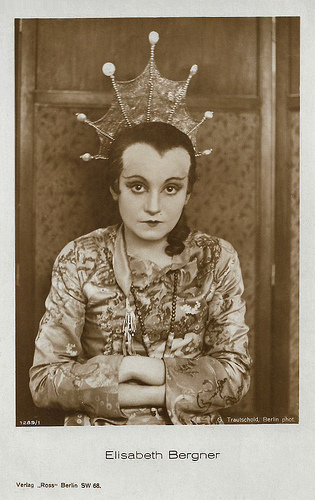
German postcard by Ross Verlag, no. 1289/1, 1927-1928. Photo: G. Trautschold, Berlin. This was a postcard for the stage play Kreidekreis (Chalk Circle), a Chinese fairy tale by German writer Klabund (or Alfred Georg Hermann Henschke). After the first night in January 1925 in Meissen with Klabund's future wife Carola Neher in the lead, Elisabeth Bergner henceforth played the lead, e.g. at the Deutsches Theater in Berlin from October 1925. The play was very successful and inspired two operas by Zemlinsky and Mors, as well as Brecht's Caucasian Chalk Circle.
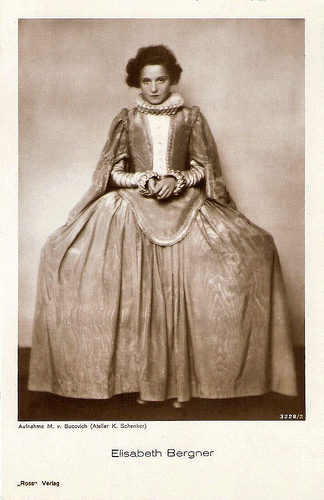
German postcard by Ross Verlag, no. 3228/2, 1928-1929. Photo: M. v. Bucovich (Atelier K. Schenker). Publicity still for Doña Juana/Donna Juana (Paul Czinner, 1928).
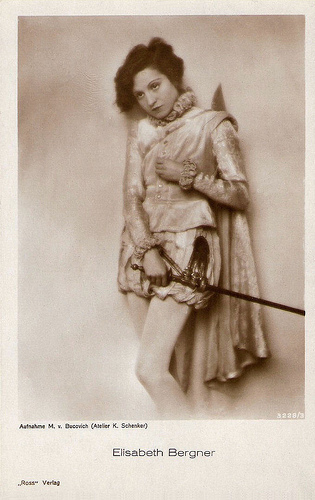
German postcard by Ross Verlag, no. 3228/3, 1928-1929. Photo: M. von Bucovich (Atelier K. Schenker). Publicity still for Doña Juana (Paul Czinner, 1928).
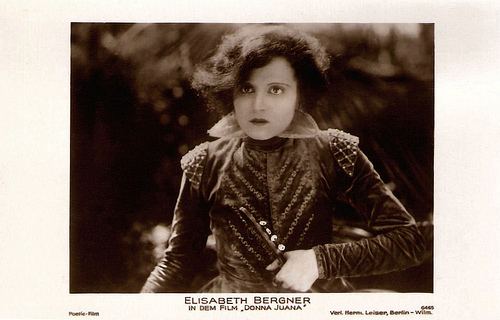
German postcard by Hermann Leiser, Berlin-Wilm., no. 6465. Photo: Poetic-Film. Publicity still for Doña Juana (Paul Czinner, 1928).
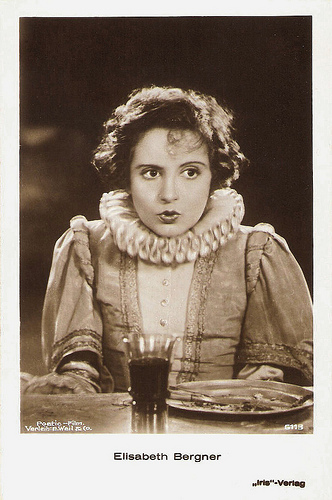
Austrian postcard by Iris-Verlag, no. 5113. Photo: Poetic-Film / Verleih: E. Weil & Co. Publicity still for Doña Juana (Paul Czinner, 1928).
Taking Berlin by storm
Elisabeth Bergner was born as Elisabeth Ettel in 1897 in Drohobycz, Austria-Hungary (now Drogobych, Ukraine). She was the daughter of a merchant, Emil Ettel, and his wife Anna Rosa Wagner. Soon after her birth, the family, whose surname had been changed to the more German-sounding Bergner, moved to Vienna.
In 1911 she was enrolled at a private acting school and from 1912 to 1915 she attended the Academy for Music and the Performing Arts. She started acting in Innsbruck in 1915. By the end of that year she had already appeared in the major role of Nora in Henrik Ibsen’s A Doll’s House.
In 1916 she moved to Zürich, where she performed at the highly-regarded Stadttheater (Municipal Theatre). She also worked as an artist's model. She posed for the expressionist sculptor Wilhelm Lehmbruck, who apparently committed suicide in 1919 because Bergner rejected his advances. She eventually moved to Munich, and in 1921 to Berlin.
On stage as Rosalind in William Shakespeare's As You Like It (a role in which she played a record 566 consecutive performances), she took Berlin by storm and won plaudits not only from theatregoers but also from such critics as Kurt Tucholsky.
She made her film debut in Der Evangelimann/The Evangelist (Holger-Madsen, 1924) with Paul Hartmann . Under Max Reinhardt's direction she reached international fame in the stage production of Saint Joan (1924) by George Bernard Shaw.
She specialised in playing Hosenrollen (women in trousers with childlike or boyish traits), and captivated spectators and critics in such stage productions as Romeo and Juliet, Queen Christine, and Camille.
Elfi Pracht-Jörns describes the 'Bergner Phenomenon' beautifully: "Seemingly contradictory elements created an inimitable aura, the magic she projected: she was at one and the same time both a tender, fragile child-woman and a 'femme fatale'. Behind her dreamy manner and engrossed concentration one could detect intellect, vitality, tenderness, a strong will, humour and wit. With her androgynous appearance, nervous gestures and capacity for total selflessness, Bergner embodied a new, erotic ideal, a complex, fastidious type of female."
Hungarian director Paul Czinner, who had come to Germany from Budapest via Vienna, gave Elisabeth Bergner a role in Nju - Eine unverstandene Frau/Husbands or Lovers (Paul Czinner, 1924). The film was an instant success, and Czinner became both her artistic and private partner.
Their successful collaboration also included films like Der Geiger von Florenz/The Violinist of Florence (1926), Liebe/Love (1927), Doña Juana (1928), and the Arthur Schnitzler adaptation Fräulein Else/Miss Else (1929). Among her co-stars were the great film actors Emil Jannings , Conrad Veidt , and Albert Bassermann .
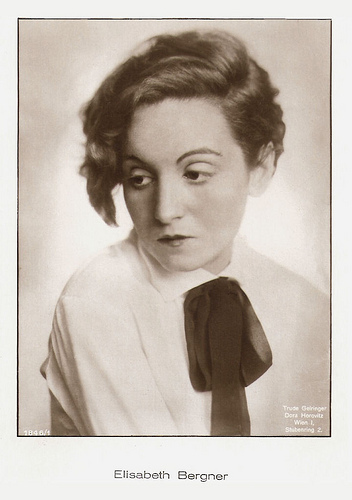
German postcard by Ross Verlag, no. 1846/1, 1927-1928. Photo: Trude Geiringer & Dora Horovitz, Wien. (The upper and lower edges of this card were cut off by a previous owner).
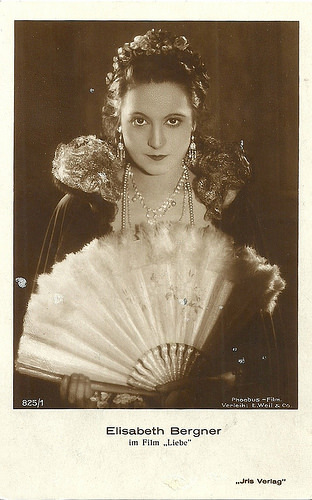
Austrian postcard by Iris Verlag, no. 825/1. Photo: Phoebus-Film / Distr. E. Weil & Co. Elisabeth Bergner in the German silent film Liebe/Love (Paul Czinner, 1927), based on Honoré de Balzac's novel La duchesse de Langeais.
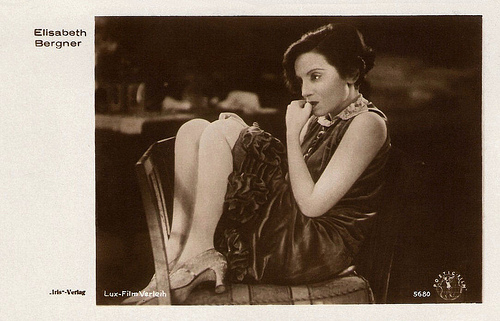
Austrian postcard by Iris Verlag, no. 5689. Photo: Poetic Film / Lux-Film Verleih.
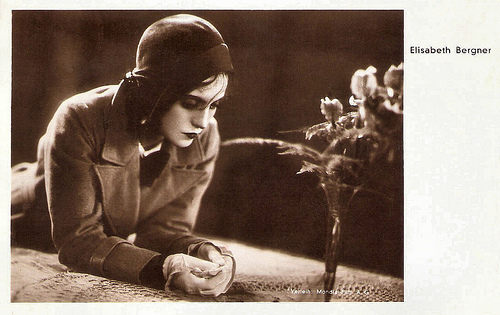
Austrian postcard by Iris Verlag, no. 6127. Sent by mail in the Netherlands in 1931. Photo: Mondial-Film A.G.
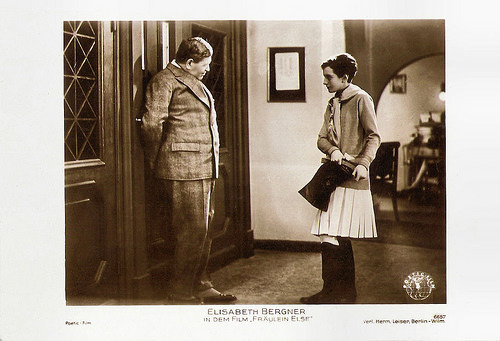
German postcard by Verlag Herm. Leiser, Berlin-Wilm, no. 6657. Photo: Poetic-Film. Publicity still for Fräulein Else/Miss Else (Paul Czinner, 1929), with Albert Steinrück and based on the play by Arthur Schnitzler.
Charming her audience in an almost hypnotic way
With the coming of sound, Elisabeth Bergner began to portray a more sentimental and delicate woman. Soon critics labelled her characters as fragile, emotional, or nervous. Bergner acted her roles in such a manner as to charm her audience in an almost hypnotic way.
Czinner allowed her to play the whole gamut of emotional experience in a series of films. The peak of her career is represented by her work in two films. In the first, Ariane (Paul Czinner, 1931), an adaptation of a novel by the French author Claude Anet, Bergner played a girl who plunges into adventure with an older, more experienced man (Rudolf Foster).
The second is the drama Der träumende Mund (Paul Czinner, 1932), an adaptation of a play by Henri Bernstein. Here, Bergner played a sensitive, pure woman who cannot escape her passion for a musical virtuoso, but does not want to hurt her loving husband. This film was remade by Czinner in 1937 as Dreaming Lips, with Bergner again in the leading role.
When the National Socialists came to power in 1933, Bergner, who was in England working on a new film, did not return to Berlin. Bergner and Czinner, who were both Jews, went in exile in London, where they had married in 1931. She particularly infuriated the Hitler regime by encouraging other famous actors to leave Germany, even sending them money to help them escape.
Rapidly learning English, she was soon able to resume her former stage and screen career. Her stage debut as Gemma Jones in Escape Me Never (1933) was met with great enthusiasm, and she repeated the role in New York (1935) and again for the film version, Escape Me Never (Paul Czinner, 1935), which earned her an Oscar nomination for Best Actress. Another film The Rise of Catherine the Great (Paul Czinner, 1934) was banned in Germany because of the government's racial policies, reported Time magazine (26 March 1934).
Her stage work in London included The Boy David (1936) by J.M. Barrie, his last play which he wrote especially for her. She repeated her stage role of Rosalind, opposite Laurence Olivier 's Orlando, in As You Like It (1936), the first sound film version of William Shakespeare's play, and the first sound film of any Shakespeare play filmed in England. Bergner had previously only played the role on the German stage, and several critics found that her accent got in the way of their enjoyment of the film, which was not a success. In 1938 she became a citizen of Great Britain.
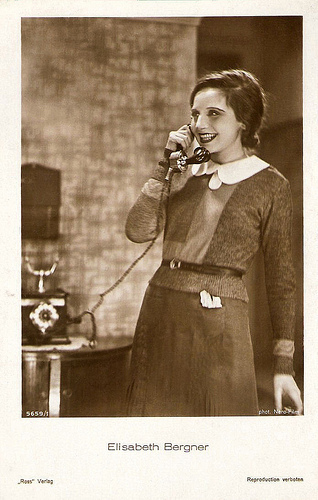
German postcard by Ross Verlag, no. 5659/1, 1930-1931. Photo: Nero-Film. Still for Ariane (Paul Czinner, 1931).
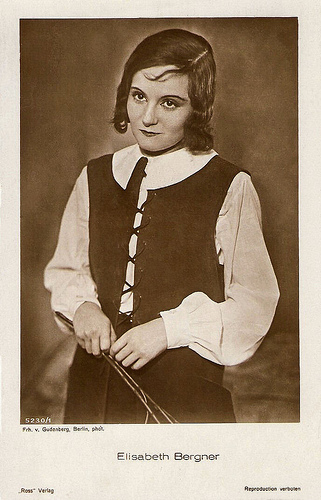
German postcard by Ross Verlag, no. 5230/1, 1930-1931. Photo: Frh. von Gudenberg, Berlin.
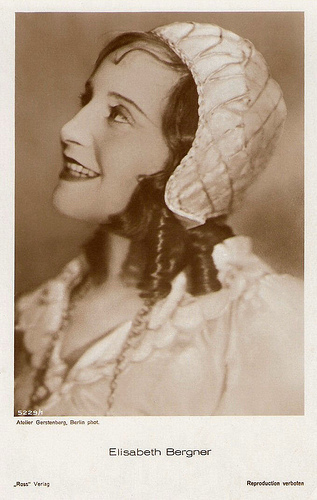
German postcard by Ross Verlag, no. 5229/1, 1930-1931. Sent by mail in 1930. Photo: Atelier Gerstenberg, Berlin.
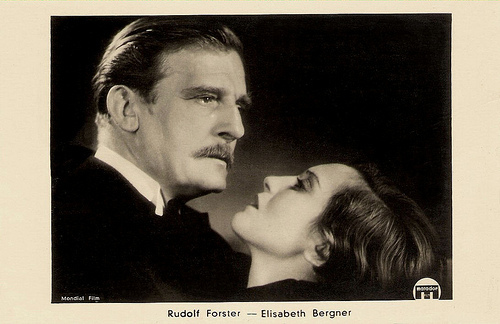
Austrian postcard by Iris-Verlag, no. 6508, distributed in the Netherlands by Jacob Stuvé's echte Nougat. Photo: Mondial Film / Matador Film. Publicity still for Der träumende Mund/Dreaming Lips (Paul Czinner, 1932) with Rudolph Forster.
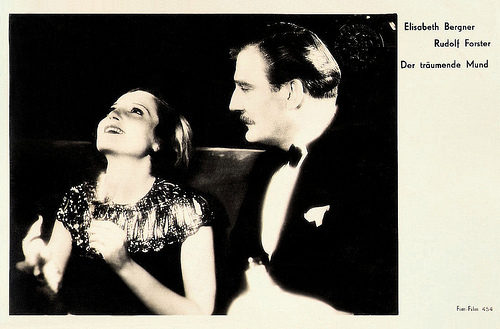
Dutch postcard by Fim Film, no. 454. Publicity still for Der träumende Mund/Dreaming Lips (Paul Czinner, 1932) with Rudolph Forster.
A Fan Called Eve
In 1940, Elisabeth Bergner and her husband emigrated to the United States. There, Bergner had to begin her career anew. While Czinner had no difficulty finding work in Hollywood, it was only at the end of 1941 that she herself received a major role in the anti-Nazi film Paris Calling (Edwin L. Marin, 1941) with Randolph Scott, which was not a success.
She returned to the stage and scored a Broadway triumph in The Two Mrs. Carrolls, which was performed more than three hundred times in 1943–1944 and earned her the Delia Austrian Medal of the Drama League of New York.
An incident with a fan/aspiring actress, while Bergner was performing in The Two Mrs. Carrolls on Broadway, inspired Mary Orr to write her short story The Wisdom of Eve. The story was ultimately filmed as All about Eve (Joseph L. Mankiewicz, 1950). In the story Eve does not get a comeuppance - as was required by the Hollywood Production Code for the film - but gets away with everything and is last seen heading to Hollywood with a thousand dollar a week contract in her pocketbook.
After the war, Bergner worked in New York, for instance in the title role of John Webster's The Duchess of Malfi in 1946. In 1950 she returned to England, and in 1954 temporarily to Germany. For nearly two decades she performed intermittently in German and Austrian theatres, and in 1970 she made her debut as a director.
In 1961, after a 20-year absence, she made a come-back for the cinema. The child-woman had been transformed into a charming, though occasionally unfathomable, old lady. Among her later film appearances were Die glücklichen Jahre der Thorwalds/The Happy Years of the Thorwalds (John Olden, Wolfgang Staudte, 1962) with Hansjörg Felmy , Cry of the Banshee (Gordon Hessler, 1970) starring Vincent Price, Strogoff (Eriprando Visconti, 1970), Der Fussgänger/The Pedestrian (Maximilian Schell, 1973), and Der Pfingstausflug/The Pentecost Outing (Michael Günther, 1978) with Martin Held .
Elisabeth Bergner won awards at the Berlin Film festivals of 1963 and 1965. She became the first actress to win the Schiller Prize (1963) for contributions to German cultural life. She also received the Ernst Lubitsch Prize in 1979, and the Eleonora Duse Prize of the city of Venice in 1982. In the Berlin district of Steglitz a city park was named after her.
Husband Paul Czinner died in 1972. Her last TV performance was the lead role in Wenn ich dich nicht hätte/When I Wouldn't Have You (Konrad Sabrautzky, 1984) with Rudolph Platte . Elisabeth Bergner passed away in 1986 in her London home, aged 88. A year later her memoirs, Bewundert viel und viel gescholten (Greatly admired and often cursed), were published. The book received favourable reviews.
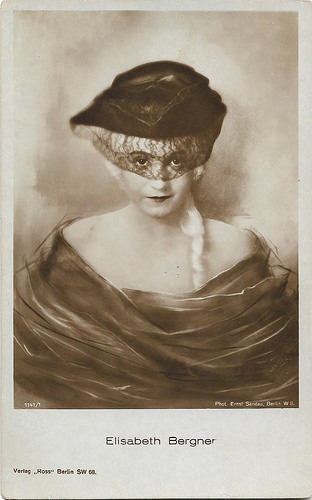
German postcard by Ross Verlag, no. 1141/1, 1927-1928. Photo: Ernst Sandau, Berlin.
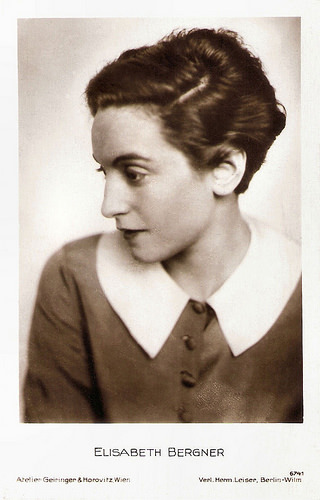
German postcard by Verlag Herm. Leiser, Berlin-Wilm, no. 6741. Photo: Trude Geiringer & Dora Horovitz, Wien.
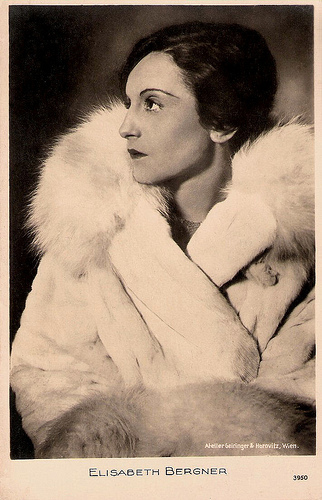
Vintage postcard, no. 3950. Photo: Trude Geiringer & Dora Horovitz, Wien.
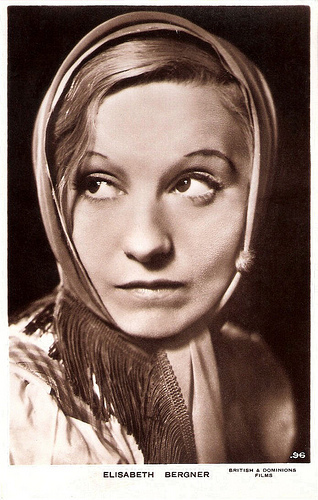
British postcard by Real Photograph, no. 96. Photo: British & Dominions Films.

British postcard by De Reszke Cigarettes, no. 24. Photo: British and Dominions. Publicity still for Catherine the Great (Paul Czinner, 1934).
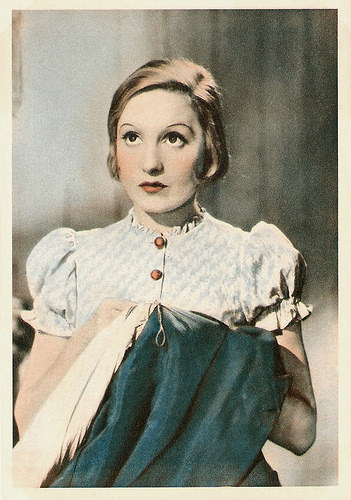
British postcard by De Reszke Cigarettes, no. 28. Photo: British and Dominions. Publicity still for Escape Me Never (Paul Czinner, 1935).
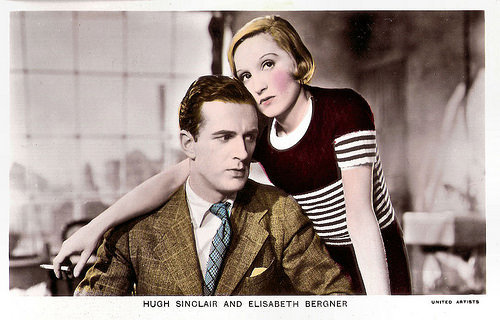
British postcard in the Film Partners Series, London, no. PC 165. Photo: United Artists. Publicity still for Escape Me Never (Paul Czinner, 1935) with Hugh Sinclair.
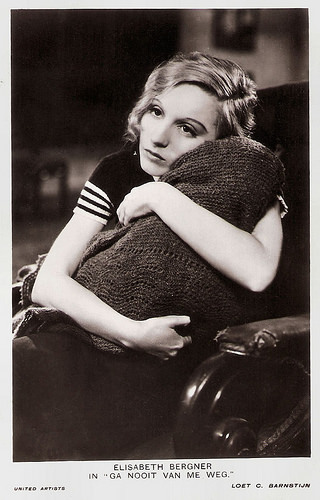
Dutch postcard by Loet C. Barnstijn. Photo: United Artists. Publicity still for Escape Me Never (Paul Czinner, 1935).
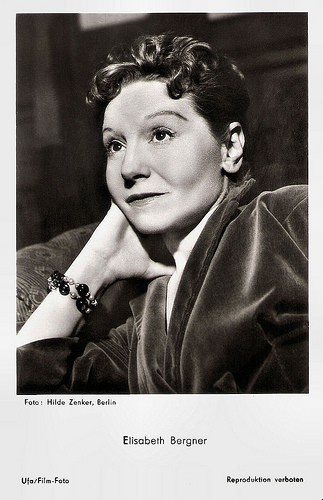
German postcard by Ufa/Film-Foto, Berlin-Tempelhof, no. FK 894. Photo: Hilde Zenker, Berlin.
Sources: Elfi Pracht-Jörns (Jewish Women's Archive), Karel Tabery (Filmreference.com), Thomas Staedeli (Cyranos), Encyclopaedia Brittanica, (IMDb), Wikipedia, and .

German postcard by Ross Verlag, no. 1289/1, 1927-1928. Photo: G. Trautschold, Berlin. This was a postcard for the stage play Kreidekreis (Chalk Circle), a Chinese fairy tale by German writer Klabund (or Alfred Georg Hermann Henschke). After the first night in January 1925 in Meissen with Klabund's future wife Carola Neher in the lead, Elisabeth Bergner henceforth played the lead, e.g. at the Deutsches Theater in Berlin from October 1925. The play was very successful and inspired two operas by Zemlinsky and Mors, as well as Brecht's Caucasian Chalk Circle.

German postcard by Ross Verlag, no. 3228/2, 1928-1929. Photo: M. v. Bucovich (Atelier K. Schenker). Publicity still for Doña Juana/Donna Juana (Paul Czinner, 1928).

German postcard by Ross Verlag, no. 3228/3, 1928-1929. Photo: M. von Bucovich (Atelier K. Schenker). Publicity still for Doña Juana (Paul Czinner, 1928).

German postcard by Hermann Leiser, Berlin-Wilm., no. 6465. Photo: Poetic-Film. Publicity still for Doña Juana (Paul Czinner, 1928).

Austrian postcard by Iris-Verlag, no. 5113. Photo: Poetic-Film / Verleih: E. Weil & Co. Publicity still for Doña Juana (Paul Czinner, 1928).
Taking Berlin by storm
Elisabeth Bergner was born as Elisabeth Ettel in 1897 in Drohobycz, Austria-Hungary (now Drogobych, Ukraine). She was the daughter of a merchant, Emil Ettel, and his wife Anna Rosa Wagner. Soon after her birth, the family, whose surname had been changed to the more German-sounding Bergner, moved to Vienna.
In 1911 she was enrolled at a private acting school and from 1912 to 1915 she attended the Academy for Music and the Performing Arts. She started acting in Innsbruck in 1915. By the end of that year she had already appeared in the major role of Nora in Henrik Ibsen’s A Doll’s House.
In 1916 she moved to Zürich, where she performed at the highly-regarded Stadttheater (Municipal Theatre). She also worked as an artist's model. She posed for the expressionist sculptor Wilhelm Lehmbruck, who apparently committed suicide in 1919 because Bergner rejected his advances. She eventually moved to Munich, and in 1921 to Berlin.
On stage as Rosalind in William Shakespeare's As You Like It (a role in which she played a record 566 consecutive performances), she took Berlin by storm and won plaudits not only from theatregoers but also from such critics as Kurt Tucholsky.
She made her film debut in Der Evangelimann/The Evangelist (Holger-Madsen, 1924) with Paul Hartmann . Under Max Reinhardt's direction she reached international fame in the stage production of Saint Joan (1924) by George Bernard Shaw.
She specialised in playing Hosenrollen (women in trousers with childlike or boyish traits), and captivated spectators and critics in such stage productions as Romeo and Juliet, Queen Christine, and Camille.
Elfi Pracht-Jörns describes the 'Bergner Phenomenon' beautifully: "Seemingly contradictory elements created an inimitable aura, the magic she projected: she was at one and the same time both a tender, fragile child-woman and a 'femme fatale'. Behind her dreamy manner and engrossed concentration one could detect intellect, vitality, tenderness, a strong will, humour and wit. With her androgynous appearance, nervous gestures and capacity for total selflessness, Bergner embodied a new, erotic ideal, a complex, fastidious type of female."
Hungarian director Paul Czinner, who had come to Germany from Budapest via Vienna, gave Elisabeth Bergner a role in Nju - Eine unverstandene Frau/Husbands or Lovers (Paul Czinner, 1924). The film was an instant success, and Czinner became both her artistic and private partner.
Their successful collaboration also included films like Der Geiger von Florenz/The Violinist of Florence (1926), Liebe/Love (1927), Doña Juana (1928), and the Arthur Schnitzler adaptation Fräulein Else/Miss Else (1929). Among her co-stars were the great film actors Emil Jannings , Conrad Veidt , and Albert Bassermann .

German postcard by Ross Verlag, no. 1846/1, 1927-1928. Photo: Trude Geiringer & Dora Horovitz, Wien. (The upper and lower edges of this card were cut off by a previous owner).

Austrian postcard by Iris Verlag, no. 825/1. Photo: Phoebus-Film / Distr. E. Weil & Co. Elisabeth Bergner in the German silent film Liebe/Love (Paul Czinner, 1927), based on Honoré de Balzac's novel La duchesse de Langeais.

Austrian postcard by Iris Verlag, no. 5689. Photo: Poetic Film / Lux-Film Verleih.

Austrian postcard by Iris Verlag, no. 6127. Sent by mail in the Netherlands in 1931. Photo: Mondial-Film A.G.

German postcard by Verlag Herm. Leiser, Berlin-Wilm, no. 6657. Photo: Poetic-Film. Publicity still for Fräulein Else/Miss Else (Paul Czinner, 1929), with Albert Steinrück and based on the play by Arthur Schnitzler.
Charming her audience in an almost hypnotic way
With the coming of sound, Elisabeth Bergner began to portray a more sentimental and delicate woman. Soon critics labelled her characters as fragile, emotional, or nervous. Bergner acted her roles in such a manner as to charm her audience in an almost hypnotic way.
Czinner allowed her to play the whole gamut of emotional experience in a series of films. The peak of her career is represented by her work in two films. In the first, Ariane (Paul Czinner, 1931), an adaptation of a novel by the French author Claude Anet, Bergner played a girl who plunges into adventure with an older, more experienced man (Rudolf Foster).
The second is the drama Der träumende Mund (Paul Czinner, 1932), an adaptation of a play by Henri Bernstein. Here, Bergner played a sensitive, pure woman who cannot escape her passion for a musical virtuoso, but does not want to hurt her loving husband. This film was remade by Czinner in 1937 as Dreaming Lips, with Bergner again in the leading role.
When the National Socialists came to power in 1933, Bergner, who was in England working on a new film, did not return to Berlin. Bergner and Czinner, who were both Jews, went in exile in London, where they had married in 1931. She particularly infuriated the Hitler regime by encouraging other famous actors to leave Germany, even sending them money to help them escape.
Rapidly learning English, she was soon able to resume her former stage and screen career. Her stage debut as Gemma Jones in Escape Me Never (1933) was met with great enthusiasm, and she repeated the role in New York (1935) and again for the film version, Escape Me Never (Paul Czinner, 1935), which earned her an Oscar nomination for Best Actress. Another film The Rise of Catherine the Great (Paul Czinner, 1934) was banned in Germany because of the government's racial policies, reported Time magazine (26 March 1934).
Her stage work in London included The Boy David (1936) by J.M. Barrie, his last play which he wrote especially for her. She repeated her stage role of Rosalind, opposite Laurence Olivier 's Orlando, in As You Like It (1936), the first sound film version of William Shakespeare's play, and the first sound film of any Shakespeare play filmed in England. Bergner had previously only played the role on the German stage, and several critics found that her accent got in the way of their enjoyment of the film, which was not a success. In 1938 she became a citizen of Great Britain.

German postcard by Ross Verlag, no. 5659/1, 1930-1931. Photo: Nero-Film. Still for Ariane (Paul Czinner, 1931).

German postcard by Ross Verlag, no. 5230/1, 1930-1931. Photo: Frh. von Gudenberg, Berlin.

German postcard by Ross Verlag, no. 5229/1, 1930-1931. Sent by mail in 1930. Photo: Atelier Gerstenberg, Berlin.

Austrian postcard by Iris-Verlag, no. 6508, distributed in the Netherlands by Jacob Stuvé's echte Nougat. Photo: Mondial Film / Matador Film. Publicity still for Der träumende Mund/Dreaming Lips (Paul Czinner, 1932) with Rudolph Forster.

Dutch postcard by Fim Film, no. 454. Publicity still for Der träumende Mund/Dreaming Lips (Paul Czinner, 1932) with Rudolph Forster.
A Fan Called Eve
In 1940, Elisabeth Bergner and her husband emigrated to the United States. There, Bergner had to begin her career anew. While Czinner had no difficulty finding work in Hollywood, it was only at the end of 1941 that she herself received a major role in the anti-Nazi film Paris Calling (Edwin L. Marin, 1941) with Randolph Scott, which was not a success.
She returned to the stage and scored a Broadway triumph in The Two Mrs. Carrolls, which was performed more than three hundred times in 1943–1944 and earned her the Delia Austrian Medal of the Drama League of New York.
An incident with a fan/aspiring actress, while Bergner was performing in The Two Mrs. Carrolls on Broadway, inspired Mary Orr to write her short story The Wisdom of Eve. The story was ultimately filmed as All about Eve (Joseph L. Mankiewicz, 1950). In the story Eve does not get a comeuppance - as was required by the Hollywood Production Code for the film - but gets away with everything and is last seen heading to Hollywood with a thousand dollar a week contract in her pocketbook.
After the war, Bergner worked in New York, for instance in the title role of John Webster's The Duchess of Malfi in 1946. In 1950 she returned to England, and in 1954 temporarily to Germany. For nearly two decades she performed intermittently in German and Austrian theatres, and in 1970 she made her debut as a director.
In 1961, after a 20-year absence, she made a come-back for the cinema. The child-woman had been transformed into a charming, though occasionally unfathomable, old lady. Among her later film appearances were Die glücklichen Jahre der Thorwalds/The Happy Years of the Thorwalds (John Olden, Wolfgang Staudte, 1962) with Hansjörg Felmy , Cry of the Banshee (Gordon Hessler, 1970) starring Vincent Price, Strogoff (Eriprando Visconti, 1970), Der Fussgänger/The Pedestrian (Maximilian Schell, 1973), and Der Pfingstausflug/The Pentecost Outing (Michael Günther, 1978) with Martin Held .
Elisabeth Bergner won awards at the Berlin Film festivals of 1963 and 1965. She became the first actress to win the Schiller Prize (1963) for contributions to German cultural life. She also received the Ernst Lubitsch Prize in 1979, and the Eleonora Duse Prize of the city of Venice in 1982. In the Berlin district of Steglitz a city park was named after her.
Husband Paul Czinner died in 1972. Her last TV performance was the lead role in Wenn ich dich nicht hätte/When I Wouldn't Have You (Konrad Sabrautzky, 1984) with Rudolph Platte . Elisabeth Bergner passed away in 1986 in her London home, aged 88. A year later her memoirs, Bewundert viel und viel gescholten (Greatly admired and often cursed), were published. The book received favourable reviews.

German postcard by Ross Verlag, no. 1141/1, 1927-1928. Photo: Ernst Sandau, Berlin.

German postcard by Verlag Herm. Leiser, Berlin-Wilm, no. 6741. Photo: Trude Geiringer & Dora Horovitz, Wien.

Vintage postcard, no. 3950. Photo: Trude Geiringer & Dora Horovitz, Wien.

British postcard by Real Photograph, no. 96. Photo: British & Dominions Films.

British postcard by De Reszke Cigarettes, no. 24. Photo: British and Dominions. Publicity still for Catherine the Great (Paul Czinner, 1934).

British postcard by De Reszke Cigarettes, no. 28. Photo: British and Dominions. Publicity still for Escape Me Never (Paul Czinner, 1935).

British postcard in the Film Partners Series, London, no. PC 165. Photo: United Artists. Publicity still for Escape Me Never (Paul Czinner, 1935) with Hugh Sinclair.

Dutch postcard by Loet C. Barnstijn. Photo: United Artists. Publicity still for Escape Me Never (Paul Czinner, 1935).

German postcard by Ufa/Film-Foto, Berlin-Tempelhof, no. FK 894. Photo: Hilde Zenker, Berlin.
Sources: Elfi Pracht-Jörns (Jewish Women's Archive), Karel Tabery (Filmreference.com), Thomas Staedeli (Cyranos), Encyclopaedia Brittanica, (IMDb), Wikipedia, and .
Published on October 29, 2018 23:00
October 27, 2018
Edna Best
Ladylike British actress Edna Best (1900-1974) entered films in 1921. She is best remembered as the mother in the original version of Alfred Hitchcock's The Man Who Knew Too Much (1934) and as the second wife of film star Herbert Marshall. She worked both on stage and in the cinema, in the United Kingdom and in the United States.
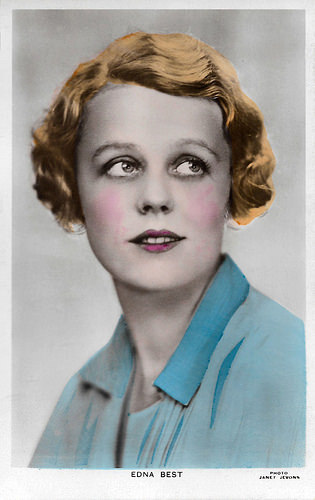
British postcard in the Colourgraph Series, London, no. C. 227. Photo: Janet Jevons.
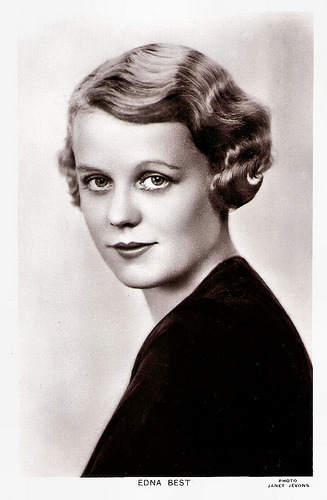
British postcard in the Picturegoer Series, London, no. 631a. Photo: Janet Jevons.
Fallen Angel
Edna Clare Best was born in in Hove, Sussex, in 1900. She was educated in Brighton and later studied dramatic acting under Miss Kate Rorke who was the first Professor of Drama at the Guildhall School of Music and Drama, London. She also won a silver swimming cup as the lady swimming champion of Sussex.
At the age of seventeen, she made her debut at the Grand Theatre, Southampton, as Ela Delahay in Charley's Aunt (1917). She played Peter Pan three years later and married the first of her actor husbands, Seymour Beard. For a time she played in musical comedies. Her first real London stage hit was in 1925 in the title role of The Constant Nymph opposite Noël Coward, and, subsequently, John Gielgud .
Another stage success was Fallen Angel with Tallulah Bankhead. In The Constant Nymph, she also enjoyed a successful run on Broadway in 1926, which was followed by another Margaret Kennedy play, Come With Me. She married her co-star, Herbert Marshall , after divorcing Beard in 1928.
In 1921 she made her film debut in the title role of the silent comedy Tilly of Bloomsbury (Rex Wilson, 1921) with Henry Kendall and Isabel Jeans. She then starred in the silent drama A Couple of Down and Outs (Walter Summers, 1923). The film sought to raise public sympathy for veterans of the First World War struggling in the years of peace as well as animals who had undergone war service. Director Summers, who had himself served during the conflict, made a number of films using the war as backdrop.
From 1930 on, she appeared in such sound films as Loose Ends (Norman Walker, 1930) with Owen Nares and Miles Mander, a drama made at Elstree Studios. In the crime film Escape (Basil Dean, 1930), she co-starred with Gerald du Maurier and Gordon Harker . Harker played a convict, who escapes from Dartmoor Prison and is hunted across the moors by policemen to whom it is an unpleasant reminder of their experiences during the First World War. It was the first film released by Associated Talking Pictures, a British company with ties to the Hollywood studio RKO, which later relocated and became Ealing Studios. The film was made at Beaconsfield Studios which had been recently equipped for making sound films.
She co-starred with Carlyle Blackwell in Beyond the Cities (Carlyle Blackwell, 1930), a ‘quota quickie’ released by Paramount Pictures. In 1931, she costarred with her second husband Herbert Marshall in the drama Michael and Mary (Victor Saville, 1931), for which they recreated their roles from the London stage. The film, which also starred Elizabeth Allan and Frank Lawton, was voted the third best British film of 1932, and was the first of the Edna Best and Herbert Marshall co-starring talkies. Next they co-starred in the racehorse drama The Calendar (T. Hayes Hunter, 1931) based on a novel by Edgar Wallace, and the drama The Faithful Heart (Victor Saville, 1932).
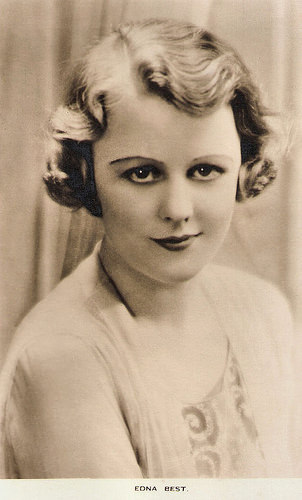
British postcard by Film Weekly Series, London.
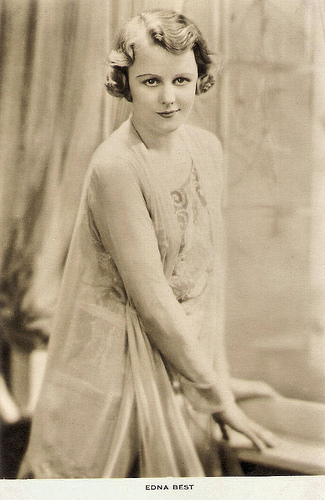
British postcard by Film Weekly Series, London, no. 2.
The Man Who Knew Too Much
Edna Best is best remembered for her role as the mother of kidnap victim Nova Pilbeam in the 1934 version of Alfred Hitchcock's thriller The Man Who Knew Too Much, featuring Peter Lorre . It was one of the most successful and critically acclaimed films of Hitchcock's British period.
At the time, The New York Times praised the film as the "raciest melodrama of the new year", noting that it was "excitingly written" and an "excellently performed bit of story-telling". The review praised Alfred Hitchcock as "one of England's ablest and most imaginative film makers”. In a retrospective review, film historian Dave Kehr contrarily argued that "Although the film is fast and consistently clever, it is more deeply flawed than any other Hitchcock film of the period, failing to find a thematic connection between its imaginative set pieces."
Edna Best moved to Hollywood where she appeared in the Pre-Code film The Key (Michael Curtiz, 1934) with William Powell and Colin Clive . The story concerns a love set during the Irish War of Independence. Among her other film credits are Intermezzo: A Love Story (Gregory Ratoff, 1939) with Leslie Howard and Ingrid Bergman , Swiss Family Robinson (Edward Ludwig, 1940), The Late George Apley (Joseph L. Mankiewicz, 1947) with Ronald Colman , and the romantic fantasy The Ghost and Mrs. Muir (Joseph L. Mankiewicz, 1947) starring Gene Tierney and Rex Harrison .
Her final film was the thriller The Iron Curtain (William Wellman, 1948), starring Dana Andrews and Gene Tierney . I.S. Mowis at IMDb: “All in all, Edna's film appearances were few and far between, and only a handful adequately showcased her talents as an actress otherwise so abundantly evident from the body of her work in the theatre.”
From 1939 a U.S. resident and a nationalised citizen by the early 1950s, Best continued her triumphant returns to the stage. Her most celebrated performances on Broadway were in Terence Rattigan's The Browning Version as downtrodden housewife Millie Crocker-Harris and in Harlequinade (1949) and as the titular character Jane (1952) in a play adapted by S.N. Behrman from a W. Somerset Maugham short story.
In 1957, Edna Best received a nomination for an Emmy Award for her role in the TV play This Happy Breed (Noël Coward, Ralph Nelson, 1957). She had appeared on television as early as 1938, in a live production of the play Love from a Stranger, adapted from the Agatha Christie short story Philomel Cottage by Frank Vosper.
Best was married three times and divorced twice. Her first marriage, to William Seymour Beard, ended in divorce in 1928. The London Divorce Court gave Beard custody of the couple's twins (James and John Beard) in granting the divorce "owing to the misconduct of his wife, Miss Best, with Mr. Marshall." The ‘Mr. Marshall’ referred to was actor Herbert Marshall , whose divorce from Hilda Lloyd Marshall ("owing to the misconduct of her husband ... with ... Miss Edna Best") was granted in the same court session.
Later, Best was married to Marshall from 1928, until 1940, and they had a daughter, actress Sarah Marshall. In 1940, Best married talent agent Nat Wolff in Las Vegas, Nevada. The judge who granted the divorce from Marshall after a five-minute closed hearing, performed the marriage a few minutes later. Best suffered a stroke in 1959, the year her husband died. She retired from acting in the early 1960s. In 1974, Edna Best died in a clinic in Geneva, Switzerland, aged 74.
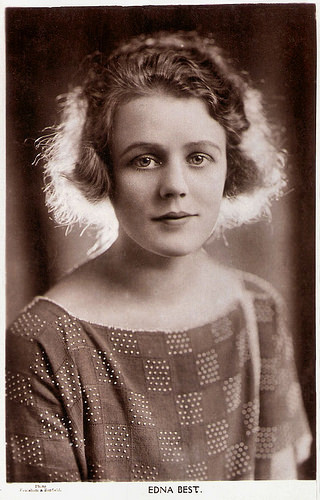
British postcard in the Picturegoer Series, London, no. 71. Photo: Foulsham & Banfield.
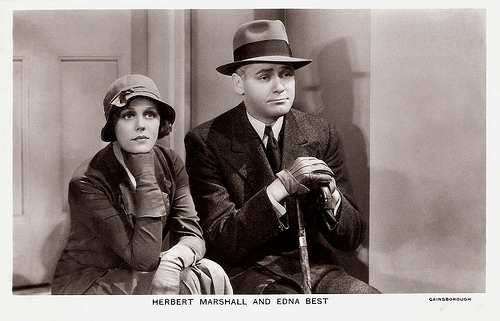
With Herbert Marshall . British postcard in the Film Partners series, London, no. P 72. Photo: Gainsborough.
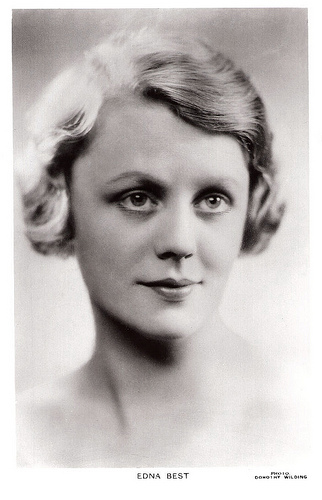
British postcard. Photo Dorothy Wilding.
Sources: (IMDb), Los Angeles Times, Wikipedia and .

British postcard in the Colourgraph Series, London, no. C. 227. Photo: Janet Jevons.

British postcard in the Picturegoer Series, London, no. 631a. Photo: Janet Jevons.
Fallen Angel
Edna Clare Best was born in in Hove, Sussex, in 1900. She was educated in Brighton and later studied dramatic acting under Miss Kate Rorke who was the first Professor of Drama at the Guildhall School of Music and Drama, London. She also won a silver swimming cup as the lady swimming champion of Sussex.
At the age of seventeen, she made her debut at the Grand Theatre, Southampton, as Ela Delahay in Charley's Aunt (1917). She played Peter Pan three years later and married the first of her actor husbands, Seymour Beard. For a time she played in musical comedies. Her first real London stage hit was in 1925 in the title role of The Constant Nymph opposite Noël Coward, and, subsequently, John Gielgud .
Another stage success was Fallen Angel with Tallulah Bankhead. In The Constant Nymph, she also enjoyed a successful run on Broadway in 1926, which was followed by another Margaret Kennedy play, Come With Me. She married her co-star, Herbert Marshall , after divorcing Beard in 1928.
In 1921 she made her film debut in the title role of the silent comedy Tilly of Bloomsbury (Rex Wilson, 1921) with Henry Kendall and Isabel Jeans. She then starred in the silent drama A Couple of Down and Outs (Walter Summers, 1923). The film sought to raise public sympathy for veterans of the First World War struggling in the years of peace as well as animals who had undergone war service. Director Summers, who had himself served during the conflict, made a number of films using the war as backdrop.
From 1930 on, she appeared in such sound films as Loose Ends (Norman Walker, 1930) with Owen Nares and Miles Mander, a drama made at Elstree Studios. In the crime film Escape (Basil Dean, 1930), she co-starred with Gerald du Maurier and Gordon Harker . Harker played a convict, who escapes from Dartmoor Prison and is hunted across the moors by policemen to whom it is an unpleasant reminder of their experiences during the First World War. It was the first film released by Associated Talking Pictures, a British company with ties to the Hollywood studio RKO, which later relocated and became Ealing Studios. The film was made at Beaconsfield Studios which had been recently equipped for making sound films.
She co-starred with Carlyle Blackwell in Beyond the Cities (Carlyle Blackwell, 1930), a ‘quota quickie’ released by Paramount Pictures. In 1931, she costarred with her second husband Herbert Marshall in the drama Michael and Mary (Victor Saville, 1931), for which they recreated their roles from the London stage. The film, which also starred Elizabeth Allan and Frank Lawton, was voted the third best British film of 1932, and was the first of the Edna Best and Herbert Marshall co-starring talkies. Next they co-starred in the racehorse drama The Calendar (T. Hayes Hunter, 1931) based on a novel by Edgar Wallace, and the drama The Faithful Heart (Victor Saville, 1932).

British postcard by Film Weekly Series, London.

British postcard by Film Weekly Series, London, no. 2.
The Man Who Knew Too Much
Edna Best is best remembered for her role as the mother of kidnap victim Nova Pilbeam in the 1934 version of Alfred Hitchcock's thriller The Man Who Knew Too Much, featuring Peter Lorre . It was one of the most successful and critically acclaimed films of Hitchcock's British period.
At the time, The New York Times praised the film as the "raciest melodrama of the new year", noting that it was "excitingly written" and an "excellently performed bit of story-telling". The review praised Alfred Hitchcock as "one of England's ablest and most imaginative film makers”. In a retrospective review, film historian Dave Kehr contrarily argued that "Although the film is fast and consistently clever, it is more deeply flawed than any other Hitchcock film of the period, failing to find a thematic connection between its imaginative set pieces."
Edna Best moved to Hollywood where she appeared in the Pre-Code film The Key (Michael Curtiz, 1934) with William Powell and Colin Clive . The story concerns a love set during the Irish War of Independence. Among her other film credits are Intermezzo: A Love Story (Gregory Ratoff, 1939) with Leslie Howard and Ingrid Bergman , Swiss Family Robinson (Edward Ludwig, 1940), The Late George Apley (Joseph L. Mankiewicz, 1947) with Ronald Colman , and the romantic fantasy The Ghost and Mrs. Muir (Joseph L. Mankiewicz, 1947) starring Gene Tierney and Rex Harrison .
Her final film was the thriller The Iron Curtain (William Wellman, 1948), starring Dana Andrews and Gene Tierney . I.S. Mowis at IMDb: “All in all, Edna's film appearances were few and far between, and only a handful adequately showcased her talents as an actress otherwise so abundantly evident from the body of her work in the theatre.”
From 1939 a U.S. resident and a nationalised citizen by the early 1950s, Best continued her triumphant returns to the stage. Her most celebrated performances on Broadway were in Terence Rattigan's The Browning Version as downtrodden housewife Millie Crocker-Harris and in Harlequinade (1949) and as the titular character Jane (1952) in a play adapted by S.N. Behrman from a W. Somerset Maugham short story.
In 1957, Edna Best received a nomination for an Emmy Award for her role in the TV play This Happy Breed (Noël Coward, Ralph Nelson, 1957). She had appeared on television as early as 1938, in a live production of the play Love from a Stranger, adapted from the Agatha Christie short story Philomel Cottage by Frank Vosper.
Best was married three times and divorced twice. Her first marriage, to William Seymour Beard, ended in divorce in 1928. The London Divorce Court gave Beard custody of the couple's twins (James and John Beard) in granting the divorce "owing to the misconduct of his wife, Miss Best, with Mr. Marshall." The ‘Mr. Marshall’ referred to was actor Herbert Marshall , whose divorce from Hilda Lloyd Marshall ("owing to the misconduct of her husband ... with ... Miss Edna Best") was granted in the same court session.
Later, Best was married to Marshall from 1928, until 1940, and they had a daughter, actress Sarah Marshall. In 1940, Best married talent agent Nat Wolff in Las Vegas, Nevada. The judge who granted the divorce from Marshall after a five-minute closed hearing, performed the marriage a few minutes later. Best suffered a stroke in 1959, the year her husband died. She retired from acting in the early 1960s. In 1974, Edna Best died in a clinic in Geneva, Switzerland, aged 74.

British postcard in the Picturegoer Series, London, no. 71. Photo: Foulsham & Banfield.

With Herbert Marshall . British postcard in the Film Partners series, London, no. P 72. Photo: Gainsborough.

British postcard. Photo Dorothy Wilding.
Sources: (IMDb), Los Angeles Times, Wikipedia and .
Published on October 27, 2018 23:00
Paul van Yperen's Blog
- Paul van Yperen's profile
- 13 followers
Paul van Yperen isn't a Goodreads Author
(yet),
but they
do have a blog,
so here are some recent posts imported from
their feed.



